Sea Kayaking For Beginners – Newbie’s Guide To Ocean Kayaking
March 14, 2024
Founder, Kayaking & Paddle Boarding Expert
Sam is the founder and editor of WaterSportsWhiz. With over 20 years of experience across various water sports, he provides trusted reviews and expert advice to help others pursue their passion for getting out on the water. When not working, you can find him kayaking, paddle boarding, or planning his next water-based adventure with family and friends.
Read Our Editorial Guidelines

Steep cliffs, secret bays, hidden beaches, patches of thick seaweed, seals that might pop up to say “Hi” – it sounds beautiful, doesn’t it?
Ocean kayaking offers endless possibilities; the perfect blend of stunning views and wild, unpredictable environments, allowing paddlers to experience open water and view the coastline from a whole new perspective.
But it also entails strong winds, changing weather conditions, choppy waters, currents – all that intimidating stuff.
So, while I get that you’re eager to hop in and start paddling, you might want to check out this guide to sea kayaking for beginners first.
We may receive a commission if you click a link on this page and then go on to purchase something, but at no extra cost to you. Learn more here.

What Is Sea Kayaking?

Here’s a quick message from our sponsor, Captain Obvious:
Sea kayaking is – well, kayaking in the sea. Duh.
All jokes aside, though, I wish the answer were that simple. I mean, technically speaking, yes, it is a type of kayaking that involves paddling across open waters. But it can include many things – from sea fishing to full-blown expedition trips and everything in between.
Plus, we are talking about a completely different environment here – even for someone who has a fair share of flat-water paddling experience.
And yes, you’ll need a specialized kayak for this.
What Is A Sea Kayak?
I know you’re going to make this wrong assumption – even some experienced kayakers do – so I figured I should address the misconception straight away:
No, a sea kayak is not the same as a touring kayak .
I get how they might look similar with their long and narrow hulls and sleek silhouettes. And you would be right to assume that many touring kayaks can be used in the seas – but not all of them are sea-worthy.
And while we’re at it, what’s the difference between a kayak and a sea kayak?
It sounds like a strangely worded question, I know, but you get what I mean by that. “Kayak,” in this sense, refers to a wide range of vessel types that are not sea kayaks, such as recreational kayaks or general-purpose boats, whitewater kayaks, and the like.
Long and narrow, sea kayaks are characterized by sharp, V-shaped hulls, integrated bulkheads , usually with abundant, water-tight storage options, and are designed with rough, open waters in mind. You’ll often see them equipped with a skeg or rudder system – although they usually offer solid tracking performance on their own, too.
Sea kayaks are not cheap as they are specialised open water boats, built to hostile conditions- so think of them as an investment. I’d suggest buying from a well-known manufacturer such as; Wilderness Systems, Perception Kayaks, or Eddyline Kayaks.
Finding the right sea kayak is an adventure all its own – don’t know where to start? Check out our list of the best sea kayaks for beginners .
Oh, and one more thing:
It might not be worth buying a sea kayak straight off – not if this is your first foray into this type of kayaking. And before you do get one, consider where you’ll store it and how you’ll transport it to the water. That last part might require a trailer , by the way.
How Hard Is Sea Kayaking?

I’ll assume that you’re not a total newbie and that you’ve had a fair share of paddling trips on the local lake or a nearby river. If I’m right, I can see how, as someone who’s used to river kayaking – waterfalls, rocks, rapids, and all that – you might be under the impression that the sea won’t be able to offer you that “Wow” factor.
What’s so exciting about seeing nothing but blue everywhere you look? Mesmerizing, sure – but adrenaline-fueling? Not so much.
That’s where you’d be wrong. Oh-so-horribly wrong.
Sea kayaking is anything but a turn-up-and-simply-paddle type of activity. There is a pretty long list of challenges you’re likely to encounter, all of which could make sea kayaking much harder than you might expect it to be – especially when compared to river kayaking .
Here are a few:
- Varying Water & Weather Conditions – You’re facing all the challenges of open waters at once. Series of waves, strong winds, powerful currents, tides – all without any shelter in sight. And the fact that the conditions can change in a matter of minutes doesn’t make it any easier.
- Requires A Certain Level Of Fitness – Surprise, surprise, you actually have to paddle when you’re out on the sea. The moment you stop, you’re leaving room for currents and winds to take over. It’s an endurance sport in every sense of the word – and you’re going to feel the strain by the end.
- Maneuvering Requires Advanced Skills – Sea kayaks are long, pointy, slender – and a real pain to maneuver without advanced paddling skills. “Stick your paddle’s blade in the water and pull” is nowhere near enough to pull this off successfully – let alone safely.
- Goes Beyond Just Paddling – Mastering essential skills and knowing what you’re doing paddling-wise is one thing. But sea kayaking requires skills that go beyond swinging that paddle of yours. Marine navigation, water safety and survival skills, and the basics of marine communications and emergency procedures, such as using a VHF radio to make a distress call, are all skills you have to master.
Also, if you ever caught yourself wondering, is sea kayaking good exercise, I’d like to add:
Even recreational kayaking can be quite a workout if you put in the effort. But paddling in open waters will kick your butt – I can promise you that.
Dangers Of Sea Kayaking: Is Kayaking In The Ocean Dangerous?

If you have to ask me, you probably know the answer. Okay, that might’ve sounded a bit too gloomy – but it’s true that it won’t be a walk in the park.
Then again, sea kayaking isn’t some death trap for kayakers to paddle into, either.
As long as the weather conditions are good and the waters aren’t working against you, kayaking in the sea is generally safe. But we both know, things are rarely ideal.
There are some potentially risky – or flat-out dangerous – scenarios you should be prepared for when you hit the seas.
Here are a few common dangers of sea kayaking to keep in mind:
- Weather – You’d be surprised how quickly strong winds, lightning storms, rain showers, and dropping temperatures can change a casual afternoon paddle into a life-threatening situation. The ocean is unpredictable – and the weather can be, too. The conditions can turn in a matter of minutes.
- Extreme Cold & Heat – Make no mistake about it; both can be deadly when you’re out on open water. Too cold, and you’re at risk of cold shock and hypothermia. Too hot, and you’re at risk of heat exhaustion and heatstroke .
- Rough Waters & Currents – One thing you should never do is undermine the power of the open waters. Again, the ocean is unpredictable. You’ll be going against rip currents, series of large waves, changing tides – all of which will try to throw you off your course.
- Boat Traffic – You’re not on a nearby lake; chances of encountering other boats – often much larger than your kayak – are pretty high. You might be able to see them from afar, but the real question is – will they be able to spot you and your plastic boat?
- Getting Lost At Sea – The mere thought of it sounds terrifying, doesn’t it? The thing is, it can be hard to maintain any sense of direction and keep track of how far you’ve paddled when there’s no shore or landmarks in sight.
- Sharks – Yes, yes, shark attacks are not as common as one might imagine – but they do happen. While you shouldn’t let your imagination run wild or let your fears get the best of you, you should be aware that encountering a shark is a genuine possibility. You paddled your ‘yak straight into their front yard, after all.
How To Start Sea Kayaking: A Few Things You Need To Master

Again, sea kayaking is far from a walk in the park – both in terms of dangers you may encounter and the technical and physical challenges you’ll have to overcome. I hope I have made that very clear by now.
How does one get into it, then?
Well, it’s going to take a bit of work. But don’t get too discouraged – as long as you master these skills, you should be ready to hit the seas.
Prerequisites: Make Sure You Have A Suitable Level Of Physical Ability
I don’t know who needs to hear this, but:
If your current physical fitness levels are less than optimal, you have no business going on an open-water paddling trip.
And no, this isn’t me shaming you for being a couch potato. I’m hoping to get you to realize that this isn’t one of those hop-in-and-hope types of outings.
Kayaking in open water will be anything but easy – technically, physically, and mentally – and you need to be 100% sure you’re cut out for the task.
So, ask yourself:
- Are you physically fit? How’s your endurance?
- Are you a strong swimmer?
- Do you know how to re-enter a kayak from the water?
- Have you paddled long-distance before?
- How much flat-water experience do you have?
If you have any doubts about your ability to tackle the challenges the sea might throw your way, I recommend that you reconsider heading out for now.
Know your limits – and respect them.
Take A Lesson
Spending a day or two with a certified instructor will not only get your paddling technique up to a good standard but also help you overcome any fears you might have regarding paddling in open waters.

It’s not about lulling you into a false sense of security; the ocean will always be an unpredictable territory. It’s about building up your basic skills, getting familiar with different conditions in a controlled manner, and, in turn, building both competence and confidence.
For first timers this might include dry land instruction on how to set up your own kayak; seat and foot peg adjustment in order to get the paddling position, rudder and foot pedals set-up, and how to outrig your ‘yak for ocean expeditions.
Controlling a sea kayak is a whole different ball game than than of a recreational kayak, so I would advise you to go over paddling techniques and master the fundamental paddle strokes, including:
- Basic forward strokes and reverse strokes
- Sweep strokes (forward and reverse)
- Positioning and maneuvering strokes, including draw and sculling strokes
- Edging your kayak
But more importantly, you have to learn key safety skills , such as:
- How to perform deep-water self-rescue (and how to assist others in your group)
- How to do a wet exit and recover from a capsize using different techniques, like the paddle float rescue, scramble (cowboy) recovery, and kayak T-rescue
- How to roll a kayak
- How to perform the side sculling maneuver

Learn How To Navigate
Remember what I said about sea kayaking requiring more than just good paddling skills? Well, learning the basics of open-water navigation is just one of the things I had in mind.
Given how easy it is to get lost at sea, I’d say learning the basics of marine navigation should be high up on your list of priorities. Don’t risk getting lost in the middle of nowhere – with only water everywhere you look.
So, make sure you have a good grasp of the basics of open-water navigation, and for the love of God – learn how to use a compass and read a map.

Learn Marine Radio Protocol
Another thing I mentioned earlier – besides navigation – is that sea kayaking also requires you to have a basic understanding of marine communications and emergency protocols. And by that, I mean knowing how to use a VHF marine radio and send a distress call.
Because one, smartphones aren’t particularly reliable in these scenarios. And two, you can only make one call at a time.
Now, keep in mind that Channel 16 (156.8 MHz) will be monitored by the US Coast Guard and is reserved for safety and distress calls. As for the actual emergency VHF radio protocols, you’ll have two options:
- Mayday , a protocol that indicates an imminent threat to life and the need for immediate assistance
- Pan-Pan , a protocol used in urgent situations that are not life-threatening
Understand (And Be Able To Read) Weather & Water Conditions
Yeah, yeah, you know how to check the weather app on your smartphone. We all do. But that’s not quite what I have in mind when I say, “be able to read weather and water conditions.”
And just so we’re clear, I don’t mean licking your pinkie to judge the direction of the wind, either.
I mean understanding how different weather conditions can affect the water – like the connection between winds and waves , for instance, the impact of tidal currents , and what a high or low tide means in terms of water levels .
The good news is that tides can be predicted accurately using these charts . As for the weather conditions, you know the drill – weather forecast .
What To Wear When Sea Kayaking?

If you’re going to stay safe and comfortable – let alone have fun – in the outdoors, you’re going to need clothing that can protect you from the elements. Unlike clothing for other outdoor sports, a kayaker’s clothing has to account for the water factor.
Water can suck the heat away from your body up to 25 times faster than air, sending you on the fast track to hypothermia. So, you have to dress for immersion – not the weather.
And that usually requires the following:
- Wetsuit , which holds a thin layer of water close to the skin, warming it up and using it as insulation – but only works when the conditions aren’t too extreme.
- Dry suit , which seals out water, keeping you dry – but it also requires insulating layers to be worn underneath.
- Base layers , mainly moisture-wicking clothes made of polyester or Merino wool – never cotton – that are worn next-to-skin.
- Shell layers , preferably with neoprene or latex gaskets at the neck and wrists that offer wind protection.
- Kayaking boots , usually made of thicker neoprene, that keep the feet dry and warm.
- Hat – again, one made of neoprene – to protect your head from cold air and brisk winds.
- Paddling gloves , which will protect your hands from extreme cold and minimize blisters – these hurt as hell in saltwater, by the way – without compromising your grip.
- Helmet – or brain bucket, if that’s what you prefer to call it – to protect the skull and, more importantly, that brain of yours.
Essential Sea Kayaking Gear Checklist: What Equipment For Kayaking In The Sea?

Okay, we talked about what to wear when sea kayaking. But we both know that there’s more a paddler needs to bring on such an outing.
So, since you’re already in the process of making a list of items to pack, let’s go over essential sea kayaking gear , too.
Obviously, a sea-worthy kayak will be a must – but other than that, you’re going to need:
- A spare paddle , preferably a two-piece one, as a just-in-case piece of equipment. It’s better to have it on board and not use it than to lose your main paddle on the open water and not have a backup solution.
- Dry bags – yes, plural – because anything that isn’t stored in a dry bag and secured to the kayak is at risk of ending up at the bottom of the ocean, or, at the very least, water damage.
- A spray skirt – because rain and large waves that are splashing left and right will not only have you soaking wet in a matter of minutes but fill up your kayak’s cockpit with water, too.
- A bilge pump is also worth mentioning while we’re on the subject of your cockpit filling up with water.
- Paddle floats – small, inflatable bags that attach to your paddle’s blades and play a vital role in performing paddle float rescue.
- Kayak lights – because you have to make yourself easy to spot out there, especially in low-visibility conditions. And a 360-degree white light is the only way to do that.
- Signaling and communication devices , starting with visual distress signals ( flares ), a noisemaker, such as an air horn or whistle, a marine VHF radio , emergency beacon , or a GPS SOS device .
- Navigation devices – because marine navigation is a serious business. You’ll need a GPS unit , a kayak compass, and a good, old map.
- An emergency survival kit , which will essentially be your bail-out bag should things go South, containing basic survival tools, including rain gear, additional thermal base layers, spare batteries, a first aid kit, rope, a Swiss army knife or multi-functional tool, water and water-purifying tablets, fire-starting supplies, energy bars, and an LED headlamp.
Since ocean kayaks generally don’t struggle with lack of storage space as much as an average ‘yak does, it’s safe to assume you won’t have trouble bringing most of these items – and more – with you.
Golden Rules Of Sea Kayaking – Remember The 5 Ps
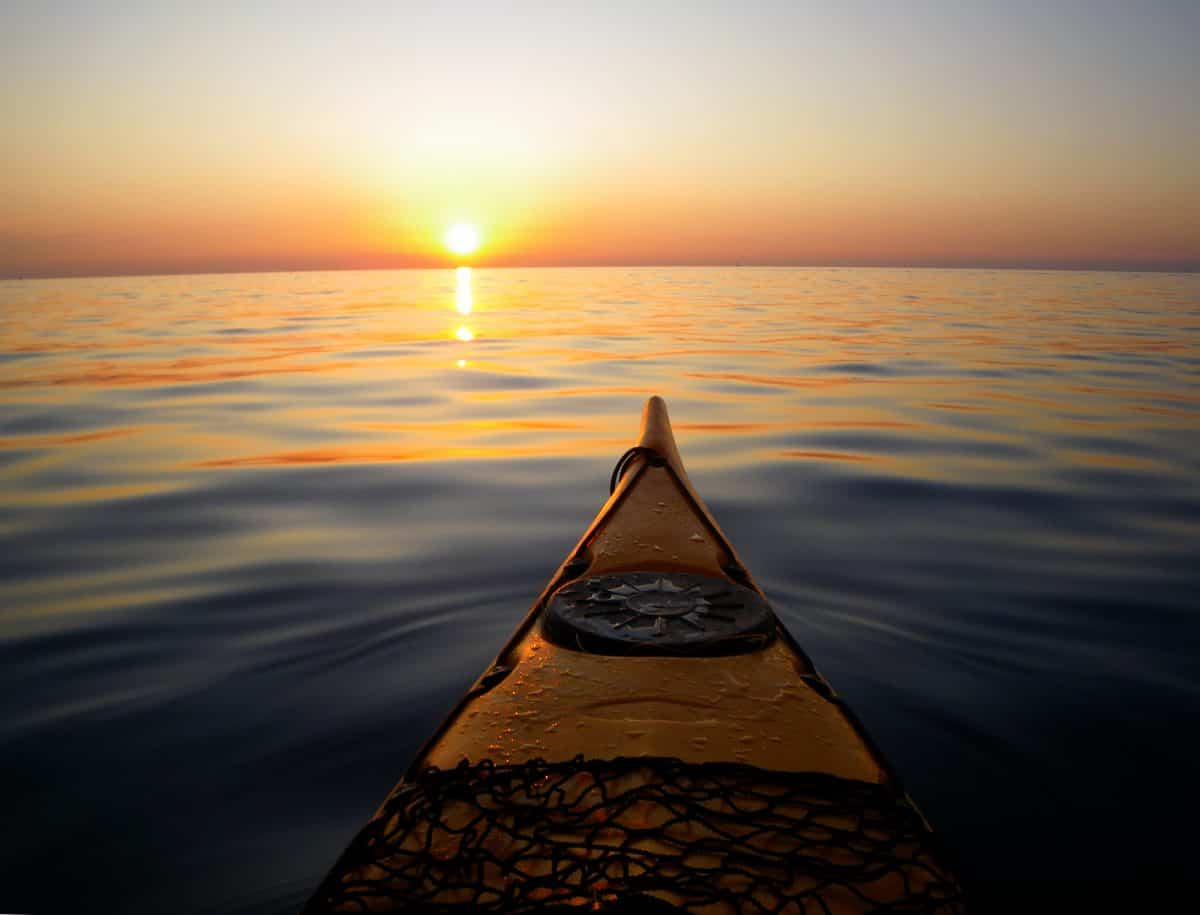
Okay, we’re nearing the end of this beginner’s guide to sea kayaking – but we’re not quite there yet. There’s one more thing – or five, if you want to get technical about it – I’d like to go over with you before we wrap things up:
The 5 Ps of sea kayaking.
#1 Plan (And Then Plan Some More)
First of all when planning a kayak trip, get familiar with the area you’ll be paddling in – and pick your route, including entry and exit spots and a plan B route, accordingly.
Proper planning is half the battle in ocean kayaking, if you ask me. And by “proper planning,” I mean:
- Map out your paddling route in advance, down to the last detail.
- Check – and then double-check – the local weather reports . Be sure to factor in how the weather conditions in the days prior to your kayaking trip might affect water temperature.
- Check the tide predictions in the area and plan the beginning and end of your outing accordingly.
Also, if you plan on clocking in more than a few miles and going further from shore – or spending the night out there – be sure to file a float plan . Someone – be it a family member or a close friend – should know where you’re going, when you expect to come back, and, most importantly, what to do if you don’t.
#2 Paddle With A Partner
Bring a friend – or four. Bring as many friends as you’d like. Whatever it takes to make your sea voyage safer.
I’m serious, though.
As much as you may enjoy the serenity of kayaking solo, you should be mindful of the fact that the ocean is one big, powerful – and pretty darn unpredictable – place. Trying to conquer it alone is a bad idea.
You’ll be glad that someone’s there if you ever find yourself requiring assistance to get back into your kayak.

Plus, it’s going to be a lot more fun if you make it a group thing. Think of it as a road trip – but in the ocean.
#3 PFD (Wear It)
I generally believe that this much should go without saying, but then I figured – it doesn’t hurt to be reminded about the importance of life vests every once in a while.
They’re called life jackets for a reason. They save lives.
The very nature of kayaking guarantees that you will end up in the water – no matter how skilled and experienced you are. But when that happens in open waters, which tend to be affected by the weather and powerful currents, wearing a PFD becomes more important than ever.
In terms of choosing a suitable life vest , make sure it fits you right and that it’s rated for off-shore use and USCG-certified. Also, I’d recommend PFDs that feature multiple attachment loops and pockets; you should keep a whistle, a waterproof flashlight, and an emergency beacon on you at all times.
Stay safe out there, folks!
#4 Practice Your Skills & Drills
I’m not saying you need to go full-on Bear-Grylls-style survival mode, but you need to know how to keep yourself alive out there should things go wrong.
Practice and hone your skills until basic paddling strokes and more advanced maneuvers, such as rolling, edging, and performing both assisted and self-rescue, become second nature to you.
And then practice some more.
You should get to a point where you can pretty much do these things without thinking – because your chances of getting out of a sticky situation depend on you being able to think clearly, make sound decisions, and react without succumbing to panic.
#5 Prepare (For Everything)
I’ve said this already – and I’ll keep repeating it until you take me seriously – but the ocean can be an incredibly unpredictable environment.
And the only way to be genuinely prepared is to – well, prepare for EVERYTHING, including the worst-case scenario. That means you need to:
- Carry a means of calling for help – and keep it on hand
- Pack an emergency survival kit
- Keep all your electronics (GPS, for example) fully charged and bring spare batteries
- Bring extra water and food for emergency scenarios
- Pack a change of clothes and a towel
- Stick close to the rest of your paddling group
Ocean Kayaking For Beginners: Summary
Getting into sea kayaking requires you to remain aware and follow certain open-water safety protocols, including:
- Choosing a sea-worthy kayak
- Wearing a PFD
- Researching the location and mapping your route
- Mastering your paddling technique
- Learning the basics of marine navigation
- Understanding weather and water conditions
- Paddling in a group rather than alone
- Understanding the dangers and being prepared for everything
Meet the Team
Affiliate disclosure.
Privacy Policy
Cookie Policy
Editorial Process
WaterSportsWhiz
2892 N Bellflower Blvd #1026 Long Beach, CA 90815 United States
+1 (562)-283-4796
We use cookies on this site to optimize site functionality and give you the best possible experience. By using this site, you accept our use of cookies. Read Our Policy
© Copyright 2019 - 2024 - WaterSportWhiz.Com
Sea Kayaking – The Complete Guide
With oceans covering most of the Earth’s surface, it’s no surprise that you want to get out there and explore it.
The rhythmic splash of your paddle, the thrill of spotting a dolphin or seal, the sheer awe of seeing a sunset from the middle of the ocean.
But, let’s be real, it’s not a walk in the park. You need to be in good shape, possess some technical know-how, and always remember: safety first.
Okay, let’s get into it
Table of Contents
What Is Sea Kayaking?
Sea kayaking is more than just kayaking in the sea when you’re at the beach. It involves more technical kayaking skills and a dedicated sea kayak to take on the open water conditions of the sea.
Sea kayakers tend to experience rougher waters, wind and stronger currents than recreational kayakers or anyone who is paddle boarding on the coast.
What’s The Difference Between A Sea Kayak And Other Types Of Kayak?
A sea kayak is different from other types of kayaks because it is specifically designed to handle ocean conditions. This means it has sufficient levels of secondary stability to handle ocean waves and rough water.
These types of boats also have a long and narrow hull to cut through water, allowing for fast and efficient paddling in wind and strong currents or waves. They usually have V-shaped hulls with a sharp bow and stern. And they will often have built-in bulkheads for added buoyancy.
Sea kayaks can look similar to touring kayaks. But the main difference between a touring kayak and a sea kayak is the design of the hull. Some touring kayaks are only able to handle flat water and have flat bottoms.
Essentially, a sea kayak is a type of touring kayak but it has the added capability to power through wind, waves, and currents.
> The best sea kayaks in review
You may find that sea kayaks have additional features to make paddling in ocean conditions easier. For example, many sea kayaks will have a rudder attached, which can help to control direction and help you maintain your course in moving water and windy weather.
Other kayaks, such as recreational kayaks, are generally not built for efficient paddling on ocean waters. This is because these types of boats are mostly designed with flatwater in mind, so tend to have a high level of primary stability but not secondary stability. They also tend to be much wider.
Unlike other types of kayaks, a sea kayak is almost always a sit-inside kayak. This is so that the kayak can be rolled easily in the event of a capsize.
The sit-inside cockpit on a sea kayak also allows for additional protection from the elements, such as wind, rain, and sea spray.
You will also usually find several storage compartments on a sea kayak, so that you can load it up with gear for a few days. There should also be room to stow your essential safety gear and equipment, such as a bilge pump and a compass.
Additionally, sea kayaks will usually have perimeter lines around the deck, which can be used as grab lines during a self rescue.
Is Sea Or Ocean Kayaking Hard?
Sea kayaking can be more difficult than recreational kayaking. If you’re used to paddling on calm, flatwater in a short, wide sit-on-top kayak then you might need to master a few extra skills before you start sea kayaking.
One of the main difficulties you might encounter is the changing water conditions. Remember, the ocean is not like your favorite flatwater lake or pond. The ocean is constantly moving, with tides and currents to contend with.
The weather conditions can also affect the sea conditions, with strong winds creating large waves and rough waters which can make paddling difficult.
You Might Need To Alter Your Paddling Technique
Sea kayaking can require you to use a more efficient paddling stroke . High angle forward strokes tend to be more efficient for sea kayaking, as it can minimize fatigue and allow you to maintain a decent speed and forward momentum.
Unlike kayaking on a small lake or slow-moving river where you’re usually able to stop paddling for a while to enjoy your surroundings, you can’t really do that on the ocean.
The currents and waves could move you and your kayak off course if you stop paddling for any length of time.
You Should Have Additional Kayaking Skills
Sea kayaking requires advanced paddling skills in addition to adjusting your paddling technique. One of the most important safety skills you should learn before you take to the high seas is the Eskimo roll or kayak roll.
This skill lets you roll your kayak in the event of a capsize using a sweep stroke with your paddle to bring you back up to the surface while remaining inside your kayak.
Video: How To Do A Sweep Kayak Roll
You should always have a spray skirt attached to you and your cockpit rim before you attempt to roll your kayak. You should also always remember to wear your life jacket every time you kayak.
If you have only ever paddled a small recreational kayak or a whitewater kayak, you might want to practice maneuvering a longer vessel. Maneuvering sea kayaks can be a little trickier than shorter vessels.
Because sea kayaks are long and narrow, they tend not to be as quick to turn as nimble whitewater kayaks, for example . But the same principle applies.
To turn quickly, you should edge your kayak by leaning slightly to one side (the outside edge of the turn you want to make). You can then use sweep strokes starting as close to the bow as possible and ending as you reach your torso.
It can be best to keep your feet on the foot peg to help stabilize yourself in the boat while you make the turn.
Video: Turn Your Kayak Quickly
You Might Need To Learn To Use Additional Accessories
Sea kayaks can have extra features that may require some getting used to. For example, you may need to learn how to use a rudder system to help you paddle in a straight line. Most rudders are controlled using foot pedals or a toe pedal inside the cockpit, allowing you to keep both hands on your paddle.
You might also need to learn how to use a VHF or marine radio. This can be useful for safety as it can let you call for help if you get into difficulty. Knowing how to send a distress call and respond to one are skills you should generally have before you head out on the ocean.
It can also be a good idea to know how to use a compass. General survival skills can also be a good shout before embarking on a kayak trip .
Safety First: Preparing For Emergencies On A Sea Kayaking Trip
No matter what type of kayaking or other water sports you plan to do, you should always be prepared for an emergency.
For starters, life jackets should always be worn. In an emergency, you may not have time to put it on before you need it, as a capsize can happen in a split second.
One of the first things you should do before you head out is check the weather conditions for your launch location and the route of your planned journey. Weather conditions can change rapidly on the coast, which means you need to be prepared to cut your trip short or postpone your launch.
If you’re a new paddler, you might want to stay close to the shore. This can keep you out of the way of boat traffic and within a safe swimming distance of land. It might be helpful for your first time to paddle near a lifeguard zone for added safety.
How Do I Start Sea Kayaking?
The first thing you should do before you start ocean kayaking is to practice basic paddling techniques on calm flatwater so that you can get to grips with water safety in a less dangerous environment.
> Can kayaking be dangerous?
It can be useful to practice kayaking on your local lake before you start paddling on the rough waters of the open ocean.
This can be particularly useful if you have never kayaked before or have only ever paddled in a sit-on-top kayak. A sit-in kayak can feel a little different for beginner kayakers.
It can be a good idea for first timers to take a kayaking lesson . A certified ocean kayaking instructor can help you develop the required skills you’ll need for sea kayaking. You should also learn safety techniques, as well as how to perform a wet exit and re-enter your kayak from deep water.
Sometimes, you might find it easier to practice rolling your kayak in the safety of a swimming pool before trying it in the wild.
Basic Sea Kayaking Tips And Techniques For Beginners
Don’t paddle alone.
As you probably already know, the ocean can be pretty darn unpredictable. And it covers a huge area. So it’s best to paddle with a partner if you’re heading off shore.
Having someone with you means if either one of you gets into trouble, the other one can come to the rescue or raise the alarm.
Avoid Bad Weather
Even experienced sea kayakers, should avoid sea kayaking in bad weather. Stormy weather can lead to very rough conditions on the water, which can be dangerous for a small kayak.
Always check the weather forecast before you head out. If you are planning a kayaking trip where you will be paddling over several days, make sure you check the forecast for the weather conditions for the duration of your trip. And keep checking it regularly to keep up to date.
Remember, the weather can change quickly on the coast.
Practice On Calm Water
We’ve said it before but practice your kayaking skills on calm water before you take to the open ocean.
Developing good paddling techniques and improving your skills can build your confidence in the kayak so that you have a better handle on your boat when it comes to kayaking in rougher waters.
Think Of Your Safety
As we mentioned earlier, you should always wear a PFD (Personal Flotation Device) when kayaking on the ocean – or anywhere else for that matter. This is what will help to keep you afloat if you capsize or if you have to swim to shore.
You should also make sure you know how to send a distress signal on a marine radio. And you should always have a whistle attached to your PFD in case you need to signal for help or alert someone (or another vessel) to your position in the water.
Learn How To Read The Water
Reading the water can be important for sea kayaking, as the changing tides can cause powerful currents, known as rip currents and rip tides, which can be dangerous if you get caught in them.
You should remain aware of the timings of high tide and low tide so that you know how to avoid dangerous currents.
Know How To Self Rescue
Ideally, you should be a strong swimmer if you plan to kayak in the ocean. You should be able to get yourself back to shore if necessary, either in your kayak or by swimming.
There are generally two things you can do if you capsize. One is to roll your kayak so that you and your kayak are the right way up. This allows you to remain in the kayak while you perform the correction.
The other is to perform a wet exit, which means you have to pull the grab loop on your spray skirt while you’re under the water, so that you can slide out of the cockpit.
Stay Out Of The Path Of Larger Vessels
Kayaking on the sea can mean you see much bigger boats than you’ve been used to on your local waterways. You may not have had to deal with any boat traffic before.
These large boats may not always be able to see you and may not have enough time to avoid you if they do.
This is why you should always avoid getting in the path of other boats and try to stay out of shipping lanes for your own safety.
Essential Gear For Sea Kayaking: What You Need To Pack And Wear
A PFD is an essential piece of kayaking equipment.
A life jacket can help to save your life. So it’s important that you wear it at all times while you are kayaking.
Spare Paddle
Having a spare paddle with you can be vital if something happens to your main one.
A four-piece paddle can be easily stowed inside a hatch.
First Aid Kit
A first aid kit can be essential for all outdoor sports, not just sea kayaking.
Whistle
A whistle or other suitable sounding device is generally required by the US Coast Guard for paddling in coastal waters.
This helps you to remove water from your cockpit. Unlike most sit-on-top boats that are self-bailing, sit-inside sea kayaks need to be manually bailed if water enters the cockpit.
Bilge pumps can do this quickly while you’re on the water.
> We think these bilge pumps are the best
A dry bag is a useful piece of equipment for keeping your essential gear safe and dry. Dry bags can be safely stored inside storage hatches or secured to the deck.
Spray Skirt
Good spray skirts help the spray and rain out of your cockpit, helping to keep your lower body dry. It also helps to keep out water when you need to roll the kayak.
Spray skirts are worn around your waist and are connected to the rim of the cockpit, creating a secure seal.
Navigation Devices
Kayaking on a large body of water like the sea means it’s easy to get lost. A compass and GPS device can be ideal accessories to bring along with you on your sea kayaking trip.
Here are some of the best GPS devices for kayaking .
Suitable Clothing
You should wear suitable clothing for the conditions that you will be paddling in. If you plan to paddle in cold water, you should wear a wetsuit or drysuit that is designed to handle cold temperatures.
Even if the weather is warm, the water temperature may not always be warm. So consider how cold you might be if you capsized. Always dress for a capsize.
Here are some tips on what to wear when kayaking .
Multi-Day Trips
Along with all the essentials and safety gear you’ll need for your kayaking trip, you will also need to think about bringing enough food and drinking water for the duration of your adventure.
Always pack more food and water than you think you’ll need. This way, if your trip gets extended unexpectedly, you’ll have enough supplies to keep you going.
You’ll also need to pack kayak camping equipment , such as a tent and sleeping bag, if you plan to stay overnight in remote areas or beaches. You’ll probably also need to pack cooking equipment.
If you’re paddling in a group, you can split the gear up between boats to help balance your load.
Sea Kayaking Destinations: The Best Places To Paddle Around The World
Alaska is home to the stunning Kenai Fjords National Park , which can provide the perfect backdrop for a sea kayaking trip. There are several glaciers that can be seen from the water.
You may also have the chance for close encounters with one of the many resident orcas, making it a bucket-list experience for many people.
> Kayaking places in Alaska
If tropical islands are more your thing, Hawaii is home to numerous islands and some of the world’s best sea kayaking opportunities. The Na Pali Coast is one of the most magnificent coastlines and can be best experienced from the water in your own kayak.
This wild coast features towering cliffs and forms part of a protected State Wilderness Park.
> Hawaii kayaking places
Greek Islands
The calm, clear waters of the Aegean and Mediterranean can be best explored by sea kayak. You can paddle alongside ancient monuments of the picturesque Greek Islands. With literally thousands of islands, there is no shortage of places to paddle.
You can explore sea caves and tunnels, discover hidden beaches and coves, and even check out shipwrecks.
United Kingdom
Kayaking the UK – thousands of miles of rugged coastline to explore, with a variety of different landscapes and geology.
Scotland can offer some of the best sea kayaking opportunities in the UK, with hundreds of islands offering unique experiences.
The west coast of Scotland, in particular, has pristine beaches with white sand, turquoise water, and plenty of marine life.
As the second largest country in the world, Canada can offer miles of sea kayaking trips along remote coastlines on the Pacific, Atlantic, and Arctic Oceans. Vancouver Island can be a good place to begin, with access to the Strait of Georgia and the San Juan Islands.
This area is known for its killer whales, with lots of guided tours offering chances to spot these magnificent mammals in their natural habitat.
New Zealand
Another great place for kayaking with whales is New Zealand, where you can spot them just about anywhere on the coastal waters.
Hauraki Gulf Marine Park near Auckland can offer excellent sea kayaking and whale watching opportunities, as can Kaikoura on the South Island.
Baja California in northwestern Mexico offers a unique opportunity to paddle along the second-longest peninsula in the world.
You can explore the Unesco World Heritage site, which includes the Sea of Cortez and its 244 islands and islets in the Gulf of California.
Or you can take to the wild waters of the Pacific.
Conclusion: Now You’re Ready For An Unforgettable Kayaking Adventure On The Ocean Waves!
Sea kayaking is an adventurous and rewarding activity that offers a unique way to experience the beauty and diversity of coastal environments.
But safety is highly important.
If you make sure you’re prepared with the right skills, safety equipment, and a little paddling experience, sea kayaking can be a fantastic way to connect with nature and the endless possibilities that the sea provides.
Leave a Comment Cancel reply
Amazon and the Amazon logo are trademarks of Amazon.com, Inc. or its affiliates
© Copyright 2024 by Kayak Guru.

- Sea Kayaking
Baja and British Columbia Sea Kayaking Tours
- Core Adventures
Sea Kayaking Tours
Offering the rare and up-close wildlife encounters, our sea kayaking trips are simply the best! They have guests come face-to-face with inquisitive sea lions, playful dolphins and immense whales while experiencing spectacular wilderness areas. We have been known for our sea kayaking trips for decades and strive to create immersive experiences and unforgettable moments.
We hand-select the destinations and craft the perfect sea kayak programs on earth. Come on an Islands of Loreto Bay tour through the wildlife-filled Sea of Cortez and even bunk down at one of our exclusive camps on the Pacific Coast at Magdalena Bay. You can also encounter playful orcas and humpback whales near the Robson Bight Ecological Reserve on an expedition to Vancouver Island as you kayak in British Columbia. We also offer award-winning kayaking adventures through the glacial waters of Alaska and the marine-filled archipelago of the Galapagos Islands, as well as encounters with whales in Patagonia.
Popular Sea Kayaking Trips in Baja and British Columbia
- Kayaking in La Paz : Seven and eight day journeys to the azure water in Baja.
- Kayaking in Loreto Bay : Six, Seven and eight day tours to the Aquarium of the World, the iconic sea kayaking adventure.
- Kayaking in God's Pocket : Six days kayaking in one of the most wildlife-filled destination in the world.
- Kayaking in Johnstone Strait : Six day kayak trips with Orcas in British Columbia.
- Orca Base Camp Tour : 4 day kayaking trip in the heart of Orca territory.
Equipment, Guides and Ethics
With exceptional equipment and extraordinary guides, you know you’re in safe hands on any kayaking trip with ROW Adventures. Not only do we offer incredible wildlife experiences, our guides will share with you the fascinating natural history of each region to enrich your experience. We’re dedicated to responsible tourism and conservation initiatives, with a “leave no trace” philosophy. We were the first kayak tour operator to join the World Cetacean Alliance's Responsible Whale Watch Partnership to help raise the standards of global whale watching and have also teamed up with sustainable travel partners to ensure we’re doing our bit to preserve our magnificent natural environment.
Sea Kayaking Trip Options
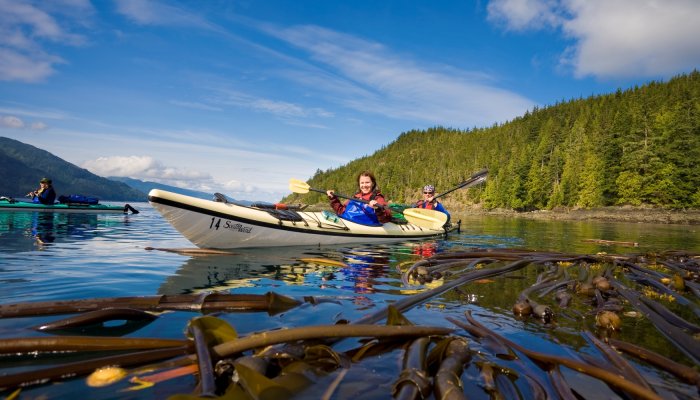
Johnstone Strait Orca Kayaking Tour
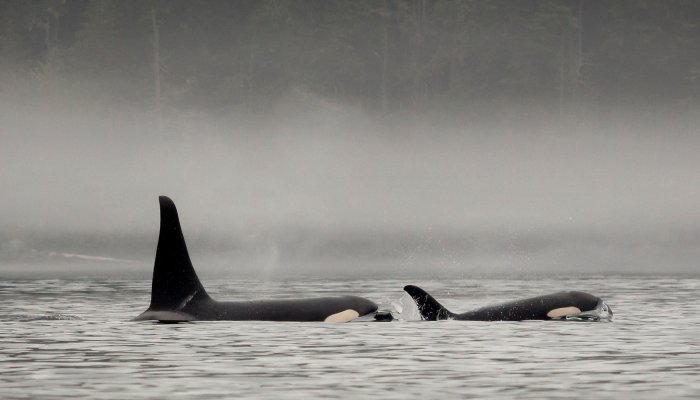
Kayak with Orcas - Johnstone Strait
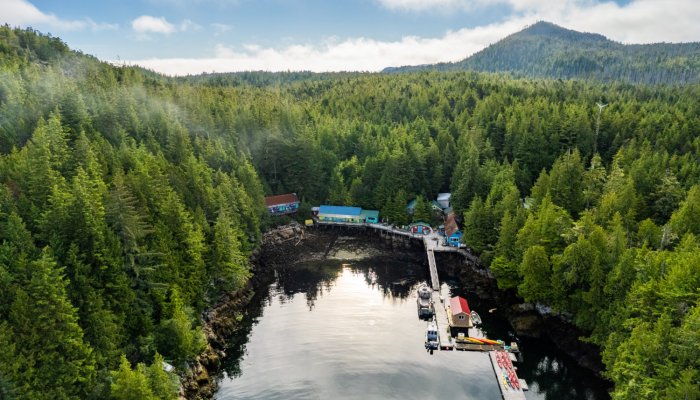
Gods Pocket Kayaking Tour
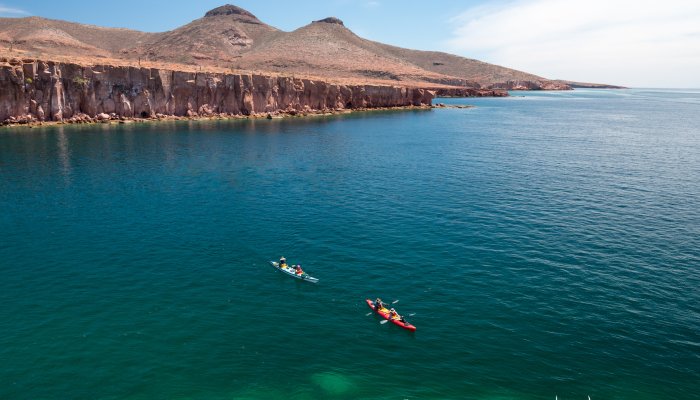
La Paz, Baja Sea Kayaking Tour
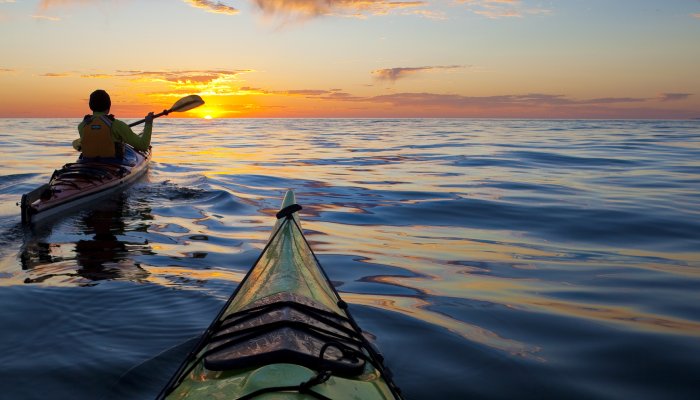
Loreto, Baja Sea Kayaking Tour
First Name * Last Name * Preferred Trip - None - Alaskan Small Ship Adventure Baja Whale Camp & Kayak Bruneau and Jarbidge River Trip Clark Fork River Rafting Clearwater River Rafting Coeur d’Alene and Hiawatha Trail 4-day Cycling Adventure Corsica Hiking & Kayaking Croatia Yachting Tour Cuba Island Bike Tour Culinary Whitewater Series Custom & Private Small Ship Tours in Croatia Deschutes River Multiday Rafting Trips E-Bike Tour - North Idaho's Iconic Trails Family Magic White Water Rafting Trip Galapagos Islands Vacation Galapagos Islands: Christmas Vacations Galapagos Kayaking Expedition Galapagos Unbound Gods Pocket Kayaking Tour Grande Ronde River Rafting Hiking the Snake River in Hells Canyon Historic Cave Paintings and Murals of Baja Hoanib Skeleton Coast Camp Idaho's Salmon River Near Riggins Johnstone Strait Orca Kayaking Tour Kayak with Orcas - Johnstone Strait La Paz, Baja Sea Kayaking Tour Lochsa River Rafting Loreto, Baja Sea Kayaking Tour Lower Selway Rafting Luxury French Barge Cruise Middle Fork of the Salmon Fly Fishing Middle Fork Salmon River Raft-Supported Hiking Middle Fork Salmon River Rafting Moyie River Rafting North Idaho 5-day Rails-to-Trail & Hiawatha Bike Tour Olympic Peninsula E-Bike Tour One Day Trip - Rogue River Whitewater Rafting Owyhee River Kayaking Owyhee River Rafting Peaks of the Balkans Hike Peru & Machu Picchu Peru Unbound Rafting the Snake River through Hells Canyon River Soul Journeys Rogue River Hiking Rogue River Rafting Rogue River Rafting and Camping Salmon River Canyons Rafting Trip Snake River + Lochsa River Whitewater Rafting St. Joe River Rafting Superlative Idaho Adventure The Mighty Lochsa The Mountains and the Sea of Loreto Turkey Yachting Adventure Western Cuba Cycling Tour Whitewater ROWing School Email Address * Telephone Contact Preference Please Select Phone Email Your Request Privacy Policy Leave this field blank Math question * 5 + 11 = Submit
- PaddleWays App
Suggestions
More Products »
- Kayak Touring
- Trip Planning
Kayak Touring » Trip Planning
- How To Choose (6)
- Trip Planning (5)
- Maintenance & Repair (17)
- Skills & Tips (8)
- Safety (13)
- All Apparel
- How To Choose (22)
- Trip Planning (19)
- Maintenance & Repair (43)
- Skills & Tips (63)
- Safety (63)
- All Rafting
- How To Choose (11)
- Trip Planning (13)
- Maintenance & Repair (12)
- Skills & Tips (64)
- Safety (69)
- All Whitewater Kayaking
- How To Choose (10)
- Trip Planning (14)
- Maintenance & Repair (19)
- Skills & Tips (61)
- Safety (46)
- All Kayak Touring
- Trip Planning (6)
- Maintenance & Repair (22)
- Skills & Tips (35)
- Safety (31)
- All Stand-Up Paddling
- How To Choose (1)
- Trip Planning (10)
- Skills & Tips (13)
- All Camping
- How To Choose (36)
- Trip Planning (31)
- Maintenance & Repair (67)
- Skills & Tips (136)
- Safety (94)
- All View All
Stay up to date on new arrivals, email exclusives, sales and more.
By providing this information, you are opting to receive email communications from nrs.com and agreeing that you have read our privacy & cookie policies.
877.677.4327
Give us a call.
Send an Email
Drop us a line anytime.
Find a Dealer
Locate our retail partners.
Learn Center
How-to articles, videos and more.
Flagship Store
Showcasing the best of NRS in Moscow, ID.
Let them pick exactly what they want.
- Duct Tape Diaries Blog
- Discount Programs
- International
- NRS Pro Deals
Customer Service
- Free Shipping*
- Rock Solid Guarantee
- Return Instructions
- Warranty Registration
- Notice at Collection
- Terms & Conditions
- Privacy & Security
- Cookie Policy
- Sun Protection
- Base Layers
- Jackets & Hoodies
- Splash Wear
- Life Jackets
- Safety Equipment
- Cleaning & Maintenance
- Apparel & Gasket Repair
- Warranty Info
- Logo T-Shirts
- Whitewater Kayaking
- Stand-Up Paddleboarding
- Dry Duffels
- Map & Electronic Cases
- Yakima Racks
- Locks & Security
- Foam Rack Kits
- Whitewater Paddles
- Touring Paddles
- SUP Paddles
- Raft Paddles
- Canoe Paddles
- Paddle Accessories
- Rescue PFDs
- Fishing PFDs
- Low-Profile PFDs
- Women’s PFDs
- Kids’ PFDs
- Accessories
- Knives & Tools
- Rope & Webbing
- Carabiners & Rescue Hardware
- Touring Safety & Accessories
- Rescue Kits
- Medical Kits
- Safety Accessories
- Chairs & Tables
- Hammocks & Shelters
- Sleeping Pads
- Stoves & Firepans
- Camp Kitchen
- Purest Duffels & Bags
- Ground Mats
- Toilet & Waste Systems
- Water Filters
- Toys & Fun
- Lights & Headlamps
- Audio & Accessories
- Waterproof Cases
- Expedition Series
- Otter Series
- Otter Livery Series
- Slipstream Fishing Series
- Approach Fishing Series
- Outlaw Series
- Select Series
- Starlite Series
- NRS Catarafts
- STAR Catarafts
- AIRE Catarafts
- Cataraft Accessories
- Tributary IKs
- IK Accessories
- Raft Frames & Parts
- Oars & Accessories
- Outfitting & Accessories
- Dry Bags & Cases
- Inflatable SUP Boards
- SUP Accessories
- Fishing Rafts
- Fishing Raft Frames & Parts
- Personal Fishing Inflatables
- Fishing Outerwear
- Fishing Apparel
- Kayak Outfitting
- Roof Racks & Transport
- NRS Apparel
- Chaco Footwear
- Crazy Creek
- STAR Inflatables
- Used Apparel
- Used Inflatables

FIND IT, PLAN IT, PADDLE IT

Ultimate Sea Kayak Beginners Guide & Tips
Sea kayaking is an ancient past time for coastal dwelling communities. While many early humans relied on it as a means to fish for one of their main food sources, sea kayaking these days is much more recreational.
This sport offers exceptional wildlife viewing and access to spots that you can only get to via land on a motorboat. But when you’re first starting out, many sea kayaks can feel tight and unstable.
Additionally, there’s a lot to learn about currents, tides, and other ocean-specific environmental factors. That’s on top of simply learning how to operate one of the best sea kayaks for beginners.
You’ll need proper instruction before buying a sea kayak and setting out for your first paddle, but there’s also a lot you can learn before taking a sea kayaking lesson.
We’ve addressed the latter by compiling the ultimate sea kayak beginner’s guide and tips. Be sure to check out our Sea Kayak Buying Guide and choices for three Sea Kayaks for Beginners as well!
Learning The Basics
Rescue techniques and emergency maneuvers, trip planning, getting the proper paddling accessories, length and width, cockpit dimensions, skeg or no skeg, 1. driftsun sculpin, 2. old town castine 145, 3. perception kayak carolina 14, final recommendations, share on pinterest, jargon buster.
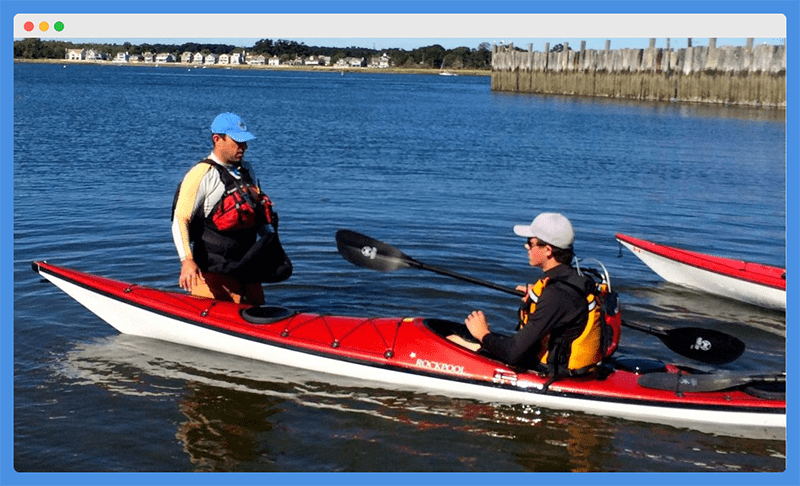
Before we get into more detailed tips for sea kayaking, we need to cover some important kayaking jargon. These are terms you’ll find later in the article, so let’s take some time to get familiar with them before moving forward.
A bulkhead in a kayak is a watertight compartment that can be used for gear storage or to add buoyancy to the kayak’s design. Bulkheads are typically located forward or backward of the kayak’s cockpit.
Capsizing is defined as flipping or rolling your kayak into an inverted position. This can be done intentionally but is more likely an accidental occurrence amongst beginners.
A skeg is a small fin that gets mounted on the stern keel (underside) of a sea kayak. They have various methods of operation but serve to provide additional tracking ability in windy conditions or when paddling across a swift ocean current.
Swells are large, rounded waves that form in the deeper ocean through the conglomeration of smaller waves caused by wind action. When they hit the shore, these swells are responsible for the waves that we see when we arrive at most ocean beaches.
Sea Kayaking Tips
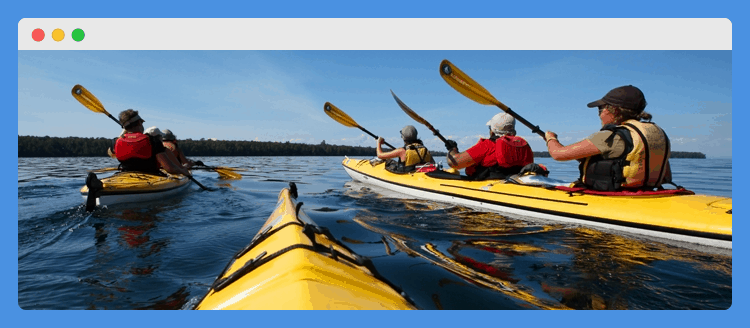
Kayaking on the ocean inherently brings more variables into the equation than paddling on lakes or rivers. So here are the most important tips to help you become a prepared and proactive sea kayaker.
There really is no substitute for taking a lesson when you’re first getting into sea kayaking.
Sure you can learn a lot by watching YouTube videos , but hands-on education and practice are really what you’ll need to build comfort and confidence.
The good news is that there are tons of outfitters and guide companies that offer sea kayaking lessons all over the world. The Kayak Academy , the American Canoe Association , and Mountaineers.org are just a few great resources for finding upcoming sea kayaking lessons in different regions.
When you’re learning how to sea kayak, make sure you’re not gripping your paddle too tight.
You should have a firm, but loose, grip so that your hands don’t fatigue too quickly and you don’t develop hot spots on the inside of your thumbs.
Beginners always have a tendency to focus on their arms and hands, as they’re the most obvious body parts responsible for operating a kayak paddle.
But proper paddling technique requires engaging your core muscles so that your arms don’t tire too quickly.
Focus on keeping your torso upright and gently twisting from side-to-side with each paddle stroke. This will help you engage your core and avoid overexertion of your arm and shoulder muscles.
The most important thing that beginners can do to remain stable in their sea kayak is to think about keeping your nose directly over your belly button.
Proper paddling technique does require a gentle core twist, but you should never be leaning too far side-to-side in order to get your paddle in the water, as this will increase your likelihood of capsizing.
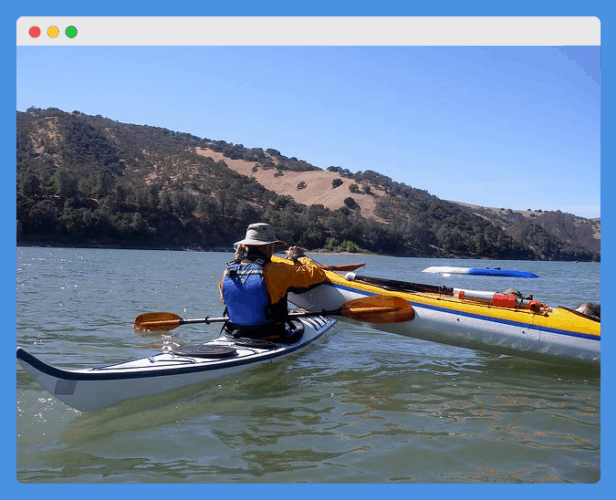
An experienced guide once said, “It’s not a matter of IF, but it’s simply a question of WHEN.” This sentiment certainly applies to sea kayaking beginners that should learn various rescue techniques and emergency maneuvers before heading out on their own.
Arguably the most important emergency maneuver you should learn as a beginner is a wet exit . This is a technique for ejecting yourself from the cockpit of your kayak if you’ve unfortunately capsized.
Practicing wet exits in a pool or shallow body of water is a great way to get more comfortable with the technique.
Even before you learn how to re-enter a sea kayak, you must know how to get yourself out quickly if needed, both with and without a spray skirt covering the cockpit.
Another rescue technique that all beginner sea kayakers should get familiar with is the T-Rescue. This method requires two kayakers, but it’s a great one to practice along with a more experienced paddle partner.
It’s a useful technique for righting an overturned kayak and assisting a paddle partner back inside.
Before you take your paddle trips to the next level, it’s really important to be comfortable with several rescue techniques and emergency maneuvers just in case you need them.
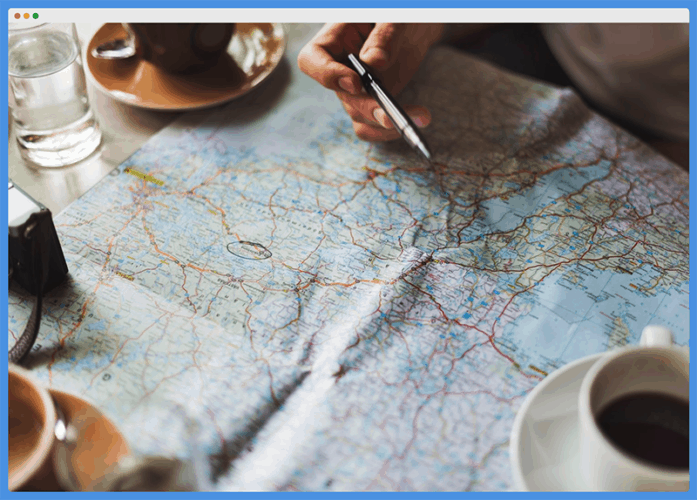
A lot of issues that new sea kayakers run into can be avoided with better planning and more thorough preparation. The best first step to planning for your paddle is to decide on a safe route.
As a beginner, it’s always best to plan a route that keeps you close to shore. This is actually a good recommendation for paddlers of all skill levels, as long open water crossings often become difficult when your bladder fills up.
Most paddlers can average 1-3 miles per hour in a sea kayak. Your exact speed will depend on wind, waves, and your personal fitness level.
This is a useful metric for planning your kayak trips because it allows you to better estimate how much distance you can cover in a reasonable amount of time. What you don’t want is to underestimate how long it will take to get to your destination and back.
Underestimating distances on the water is very common amongst beginners. It is simply harder to judge how far away “that next point” is when you’re sitting on the water in your kayak.
That’s why we recommend using a paper map (or Google Maps) to determine distances before you head out.
Google Maps actually has a useful feature that allows you to measure the straight-line distance from your current point to any point on the water you’re curious about visiting.
Understanding wind and waves are also super important to trip planning when sea kayaking. Before heading out, you should always have a good sense of the wind patterns in your area.
This will allow you to plan for returning to your starting point with the wind at your back, rather than having to fight the wind all the way home once you’re already fatigued. The Ventusky app is a great resource for wind speed, direction, and wind gusts all over the world.
Unlike all other forms of kayaking, sea kayaking requires a better understanding of the ocean. This includes knowledge about rip currents, tides, waves, wind, and also wildlife migrations.
This article is a great resource for understanding tides and how they might impact your sea kayaking expeditions. Make sure you also take some time to understand ocean currents so that you don’t put yourself in a position where you can get back to the location where you launched your kayak.
There are many paddling accessories that go along with a sea kayak. A paddle is essential, of course, but you’ll also need a quality PFD and a spray skirt, at the very least.
The benefit of having a sea kayak is that they generally boast much more storage than other types of kayaks . This allows you to bring more gear along, which should include safety gear and personal supplies.
Some good examples of safety gear that you should consider packing on your kayak for every trip include a tow rope, flotation bags, a bilge pump, a sponge, and at least one dry bag.
Most experienced sea kayakers will bring multiple small dry bags so that they can organize their gear more efficiently. Multiple smaller dry bags also tend to pack into a sea kayak’s watertight compartments more easily than one large dry bag.
Even if you’re going out for a relatively short paddle, you should always bring a first aid kit, snacks, water, extra layers (including at least one rainproof layer), and some sort of navigation technology, such as a cell phone in a dry box or a kayak-specific GPS.
But even if you’ve taken the leap and bought a really nice GPS unit, we recommend always having a waterproof map on hand as a backup.
You just never know when technology can fail and have a waterproof map is a foolproof way to help with navigation on the water.
Of course, you’ll need to know how to read and interpret what you’re seeing on the map in order to make good decisions about your route and paddle itinerary. Here’s a great resource that you can use to learn more about how to measure direction and distance using a paper map.
Sea Kayak Buying Guide
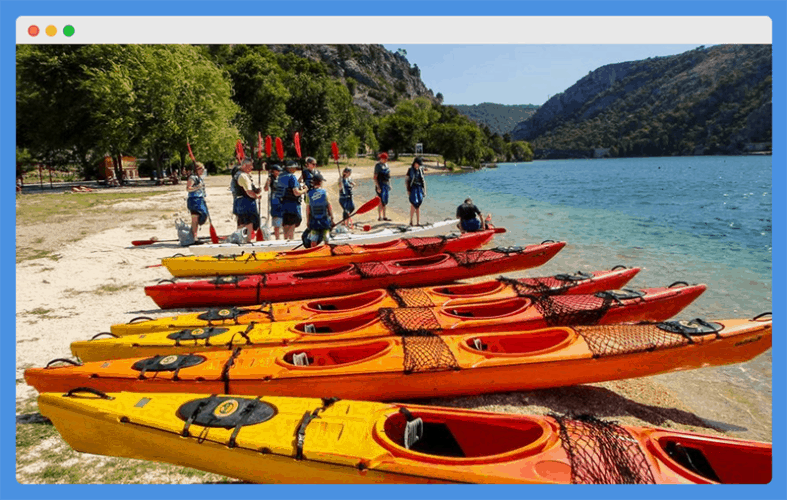
Now that we’ve covered important kayaking jargon and sea kayaking tips, it’s time to discuss choosing a sea kayak. This Buying Guide includes the most critical features and specifications to prioritize when selecting a sea kayak for beginners.
The dimensions of a sea kayak will play a large role in how easy it is to maneuver. In general, a longer kayak will achieve higher top speeds and track straighter, while a shorter kayak will offer greater maneuverability.
In other words, as a kayak’s length increases, it will be able to cover more distance in a shorter amount of time. Of course, this also depends on weather and paddler’s fitness level, but this is generally true if all other factors are equal.
The sacrifice that you’ll make with a longer kayak is a decreased ability to make quick turns or maneuver the kayak in tight spaces. This can make turning around slower if you have to help a friend or partner back into their kayak.
Shorter kayaks will be much easier to maneuver and turn, but they generally won’t cover as much distance as a longer kayak can in the same amount of time, provided all else is equal.
The width of a sea kayak largely impacts its stability. As you might imagine, a wider kayak will be more stable than a narrower version, even though this can mean sacrificing performance over distances.
Kayaks with a larger width also tend to have bigger cockpit dimensions. This is important for larger paddlers that should make sure the cockpit is big enough so they can be comfortable when on the water.
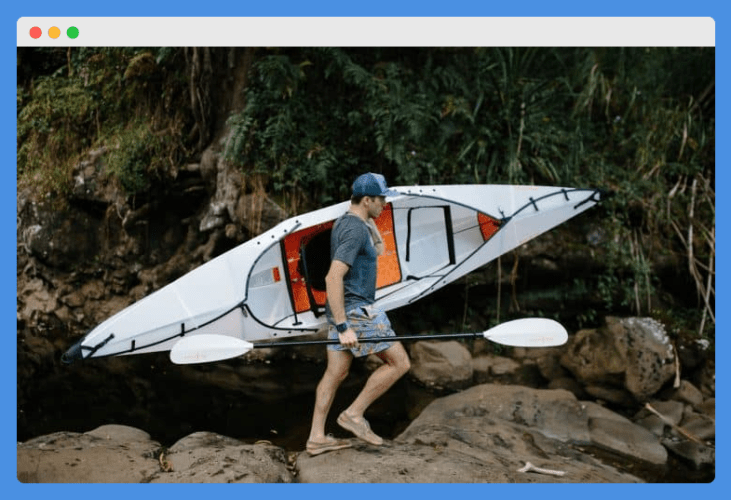
Sometimes the hardest part about being a beginner is simply transporting your kayak to and from the water. Because they tend to be longer than many other types of kayaks, sea kayaks also tend to weigh a bit more.
All beginners should consider purchasing a wheeled kayak cart to help you roll your kayak down to the water instead of having to carry it. This also allows you to load all the gear into your kayak to make one trip from car to water, rather than having to make multiple.
If you choose not to opt for a kayak cart to help with on-land transportation, simply make sure you’re comfortable carrying the weight of the kayak you choose, at least over a short distance.
Every good sea kayak manufacturer should publish cockpit dimensions of their kayaks. If they don’t, this is an automatic red flag and you should consider a kayak made by a different manufacturer.
The dimensions of a kayak’s cockpit will determine how comfortable you’ll be once you sit inside. Most of these kayaks aren’t exceptionally roomy, but you should always choose a kayak that’s roomy enough for your body type.
To help you do this, start by measuring your lower torso from hip-to-hip. It’s best to use the Iliac crest on either hip to get the most accurate measurement possible for this determination.
From there, add 12 inches to your measurement. This will give you a cockpit width measurement to shoot for when you’re searching through sea kayaks and this will allow for a full six inches of space on either side of your body once you’re sitting in the cockpit.
While this might be erring a little on the generous side, it should give you a technique for understanding how much space you’ll have in a kayak cockpit.
For example, an individual with a 16-inch hip-to-hip measurement will only have 1.5 inches of clearance on either side of their body if they chose a kayak with a 19-inch wide cockpit.
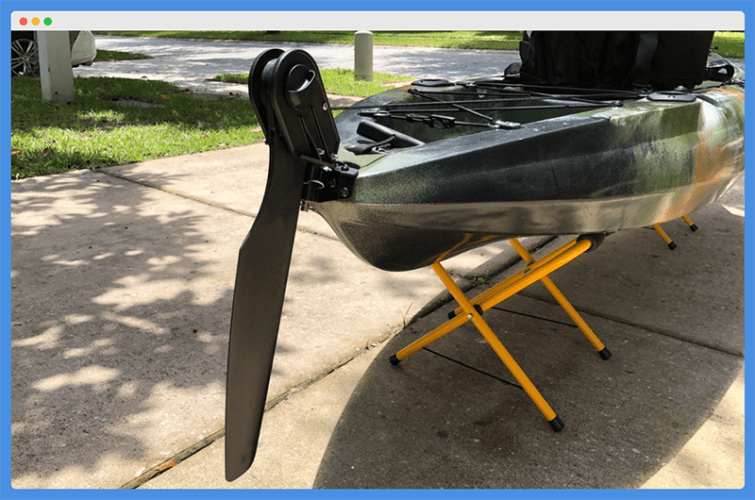
Most of the best sea kayaks come with a skeg or are compatible with an aftermarket skeg that must be bought separately and installed personally. A skeg is great for improved tracking, especially when you’re fighting winds, waves, and currents.
But a skeg can be a little tricky to operate if you’re a beginner. You’ll want to have a good grasp on your basic kayaking skills, emergency maneuvers, and rescue techniques before you start to worry about learning to operate a skeg.
Most skegs are foot-operated so that you don’t have to take your hands off your paddle to make adjustments. Some, however, require you to take one hand off your paddle to change the skeg alignment.
If you mostly plan on using your sea kayak in protected saltwater bays and coastal waterways, you might not need to worry about a skeg. This will also be the case if you don’t plan on covering a lot of distance.
But if you envision one day organizing a multi-day sea kayaking expedition, you’re going to want the benefits of a skeg. A skeg will also be an essential item if you often paddle in areas that experience high winds or heavy currents.
Although you might not want to start off with a skeg, it’s good to keep the benefits of a skeg in mind. If you’re not quite sure about this point, you can always opt for a kayak with a retractable skeg or one that gives you the ability to install a skeg later down the road.
Sea Kayaks For Beginners
The Driftsun Sculpin is a 12-foot sit-inside kayak that will help beginners learn how to handle the sea. This kayak has a foot-operated rudder at the stern that helps you track straighter when battling ocean currents.
This kayak is 26 inches wide and it has a maximum weight capacity of 330 pounds. This weight capacity allows the kayak to grow with your experience as you start to load more gear for longer trips.
Another feature that makes the Driftsun Sculpin great for beginners is the included aluminum paddle. This paddle has fiberglass-reinforced polypropylene blades that make it more durable while maintaining ease-of-use as you get used to different paddling techniques.
If you’re looking for a kayak that offers a bit more length, the Old Town Castine 145 is 14 feet and six inches long. This extra length improves the kayak’s top speed and also makes it track straighter over distance.
This is a good kayak option for larger paddlers because the extra length also translates to more legroom in the cockpit. The total cockpit dimensions of this kayak are 21 inches by 36 inches and the kayak’s total width is 26.5 inches.
For beginners, this kayak doesn’t come with a rear skeg, but it is ready for a skeg to be installed when you want one. This gives beginners the ability to get comfortable with basic paddle strokes before moving on to operating a skeg or rudder.
Best suited for sea kayaking on protected bays or coastal waterways, the Perception Kayak Carolina 14 is a great beginner’s sea kayak. It has a super-adjustable seat with extra cushioning so that you can stay comfortable on longer paddles.
This kayak is 14 feet long and measures 24.5 inches across. It’s the skinniest of the three kayaks we’ve included in this section, which means it can achieve higher top speeds but may be a little less stable when you’re first starting out.
Because it doesn’t include a rudder or skeg in the stern, it’s best for beginners that should stick to calmer ocean conditions before graduating to open water. It does have generous storage compartments so you can bring more gear along as you gain comfort and experience.
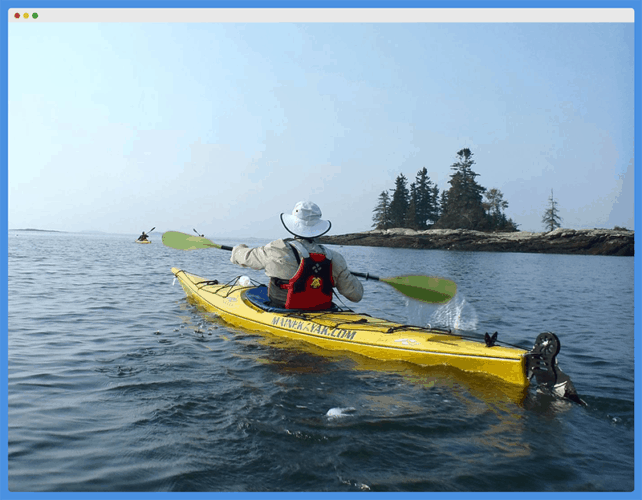
It’s a good idea to start out on calmer coastal waterways or protected bays as a novice sea kayaker. You really need to build comfort with your kayak and refine your paddling skills before introducing more variables.
This includes practicing wet exits and the various kayak rescue techniques . If you can’t get in and out of your kayak in deep water, you should be cautious progressing to open water and longer ocean paddles.
But when you are ready to progress, one of the biggest challenges of sea kayaking is the environment. Conditions are always subject to change when you’re on the water, so you’ll need to be prepared for anything.
We simply can’t overstate the importance of planning ahead, bringing extra supplies in a proper dry bag, and having the right tools to help you anticipate and proactively respond to weather changes.
And, as always, be sure that someone on land (a trusted friend or family member) knows where you’re paddling and how long you’re planning on being gone so that they can alert authorities if things don’t go as planned!
Enjoyed Ultimate Sea Kayak Beginners Guide & Tips ? Share it with your friends so they too can follow the Kayak Help journey.
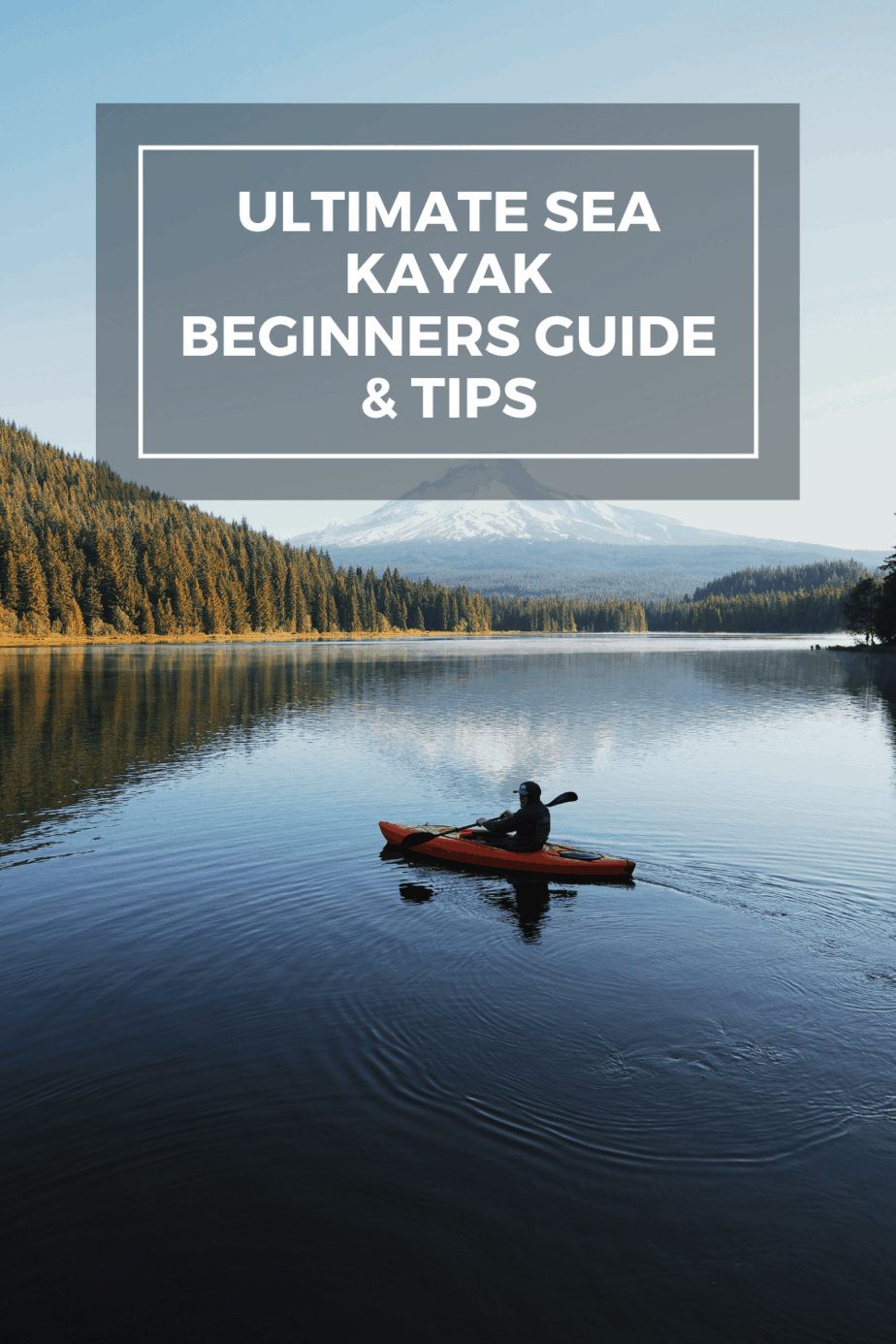
Peter Salisbury
Pete is the Owner of KayakHelp.com. Born and raised in Cleveland, Ohio, he grew up kayaking, fishing, sailing, and partaking in outdoor adventures around the Great Lakes. When he’s not out on the water, you can find him skiing in the mountains, reading his favorite books, and spending time with his family.
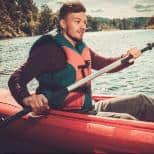

How to Plan a Multi-Day Kayak or Canoe Trip
I’ve spent more nights under the stars – or laying under a boat when I’ve forgotten my tent fly again – than I can remember. From sea kayaking trips on Norweigian fjords to camping on river beaches in Nepal, and everything in between. Heck, just last week I got back from a multi-day canoeing river trip with friends, camping on islands as we went.
Along the way, I’ve picked up a whole load of tips and tricks. And the most important is to make sure you plan your trip properly. That way, you avoid surprises. So here’s my guide to planning a multi-day kayak or canoe trip.
Pick a Trip
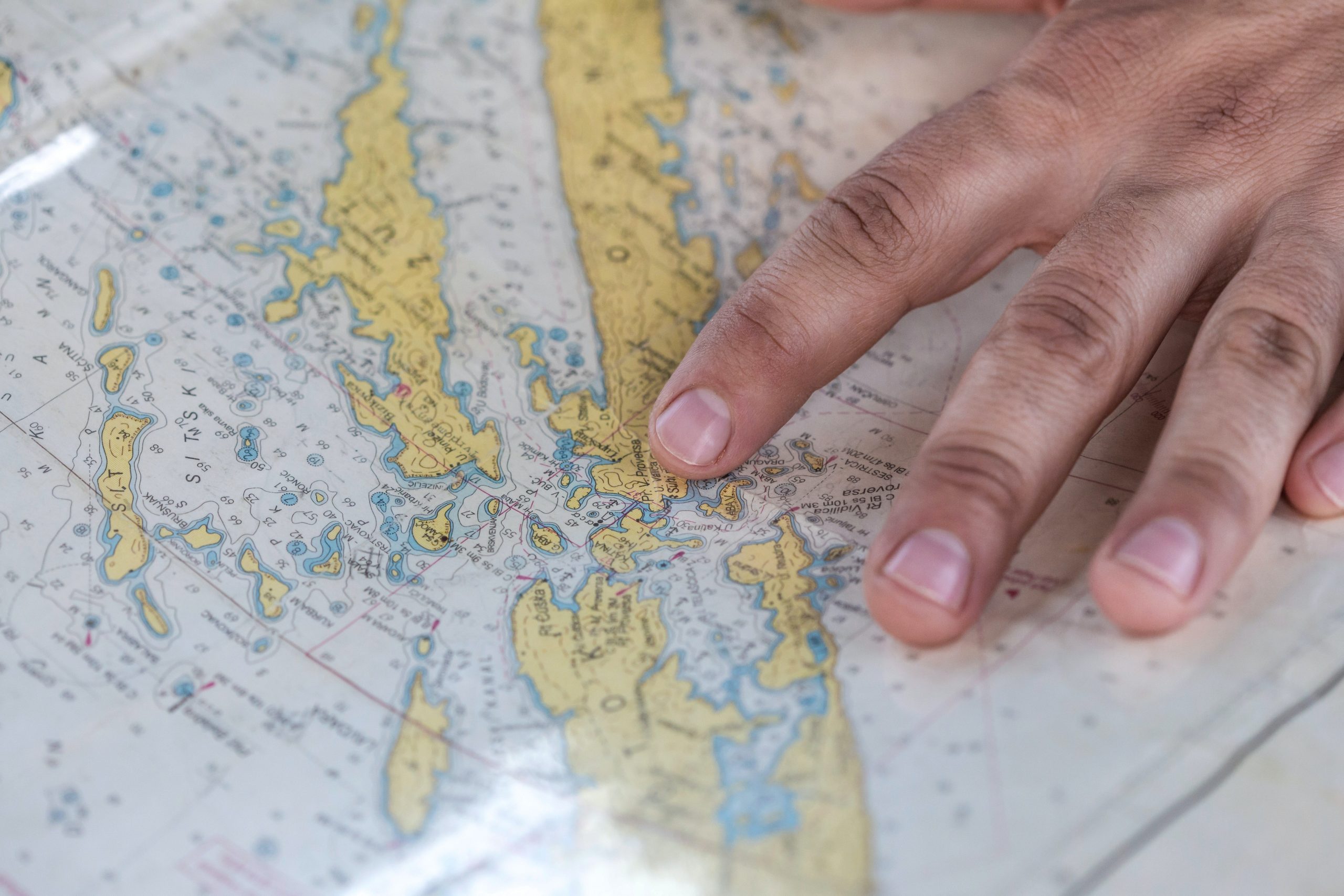
This is where I try to start planning for every trip I do. Every trip is different, even just slightly, so the sooner you have your chosen trip planned, the sooner you can start organizing it. Pick a guidebook up, check out the internet for ideas, or ask some local outfitters for their ideas on the best trips. You may also use this interactive map of places to go kayaking nearby.
The trip you chose will dictate everything. From the style of kayak or canoe you need to the equipment you will carry, the crew you take, and the skill you need on the water. You can’t start packing a tent just to decide on a trip that has no good tent camping and needs a hammock, right? Just like you can’t plan a sea kayaking trip when your whitewater kayak is already on the rooftop and ready to go.
Remember, the backcountry isn’t like your average day trip. If you’re new to overnight and multi-day trips, plan for a journey well within your capabilities. It’s not the place to be pushing your capabilities when you’re paddling a fully loaded boat and rescue is several hours away.
Research Local Guidance
Local knowledge is invaluable. Even if it’s a trip you know well if you’re traveling outside your local area get in touch with someone who lives locally. That way, you can find out about any recent changes, or anything you need to know that might affect your trip. Perhaps a mother bear has taken to raising her cubs where you were planning on camping, wouldn’t you rather know about that before you pitch up with your tent?
This local guidance can cover everything both on and off the water. Maybe there’s a campfire ban in place or a camping ban overall? What if a particular section of the river has changed, or a portage trail has been built that makes connecting two lakes easier? Really, if you’re not contacting the locals, you’re missing a trick.
Check the Conditions

As soon as there is a long-range weather forecast available, start checking it routinely. A little rain shouldn’t dampen your spirits, but strong winds can definitely affect your plans. Keep an eye on the conditions as they change on a daily basis, including river levels, lake conditions, tide times, tidal flow strength, and even things like sunrise and sunset.
Sure, these don’t all change daily. Sunrise and sunset are predictable, as are the tides, but they sure affect your journey. If you need to beat the tide, you might have to be planning to get on the water early on a particular day, or sit and wait out the wind until it drops in the afternoon. You may even consider turning your whole trip around and reversing the journey so that the wind is on your back?
In our kayaks, we’re never going to beat the environment. Sometimes, we have to accept that we need to postpone a day or wait a day out on the beach if we’re on a longer trip. But a regular check of conditions up to your day of departure can make sure you’re as prepared as possible for your overnight journey.
Check Your Crew
Are you flying solo, or are you part of a crew? If you’re going out with a group then there are certain things you need to check before you hit the water.
Firstly, is everyone in the group up to the level of the trip? As we said earlier, the backcountry isn’t a place to push your limits, so it’s a good idea to make sure you’re not asking too much of anyone or putting them in a position where they’re set up to fail.
If everyone is good to go, then it’s time to see what everyone’s bringing to the party. Is there one person taking lead on the journey – either on or off the water – or is everything going to be decided by the group? Everyone in a group has a role to play, even if it’s not obvious. Is one person particularly skilled at backcountry cooking? Has one person got medic skills? Maybe there’s a member of your group who is great at fixing things or navigating, or has some specialist kit that will make the journey that much more comfortable.
This doesn’t designate anyone a role, but by knowing what skills you have in the group then you can identify areas of weakness and plug those gaps, either with extra team members or developing those you have. Try not to get your team too big, while we’re at it. The more the merrier reaches a point where you’re trying to navigate a whole bunch of people and the trip becomes more about crowd control than kayaking.
Get Your Logistics Dialled

Do not leave this until the end. Many meticulously planned multi-day trips have come unstuck at the logistics stage, so get this planned as early as possible so that it’s out of the way and you can get on with the good stuff.
The logistics. How are you going to get everyone, all of their kayaks or canoes, and all of their gear , to the start of your trip? If you’re doing a linear trip, how are you going to get them back from the end?
This is where your crew comes in. Does anyone have a truck , or trailer , that can take multiple kayaks? Will you run a shuttle to leave a vehicle at the end of the trip, or will you use a local outfitter to run it for you and save you time?
However you do things, make sure you know where your keys are while you’re on the water. You don’t want to finish a great few days in your kayak to find that the keys to your shuttle vehicle are in the truck you left at the put-in.
Lay Out Your Gear

If you’re a serial tripper, you may know where all of your gear is. It might even be packed already – though if you’ve not unpacked since your last trip I recommend giving everything a good airing out. But for most of the world’s multi-day kayakers, gear gets put away in the garage or cupboard and has to be brought out for each trip.
Now is the time to check your equipment. Is your tent all in one place? Does it have all the pegs? Have you got enough gas to power your stove?
I would recommend laying out two piles of gear to check through. Have one pile of your kayaking gear, including what you’re planning to wear on the water, and any safety equipment – helmets , spare paddles , bilge pumps – there too. Then make a separate pile of camping equipment. Remember to check in with your crew at this point. There are some things that everyone needs – a sleeping bag, PFD – but some things – stoves, first aid kits – don’t need to be carried by everyone.
Here is a simple packing list, but feel free to add to it, alter it, and make it your own. It also doesn’t cover specialist equipment that you might need for fishing trips or safety gear for rivers or open-water touring.
Individual Gear
- Kayaking/Canoeing equipment – kayak/canoe , paddle(s) , PFD , cag, spray skirt , etc.
- Sleeping bag
- Tent – unless you’re sharing – or hammock, bivvy bag, tarp.
- Spare clothes – for off the water – weather dependent
- Spare footwear – for off the water
- Water bottle
- Personal medication
- Insect/bear deterrent
- Headlamp and spare batteries
- Spare paddles and on-the-water safety gear
- Tarp – always a good idea for cooking under, sitting under etc.
- First aid kit
- Firewood and fire starter – if permitted
- Saw/axe – if firewood collection is permitted
- Navigation equipment
- Water purification
- Toilet tube – trowel, TP, sanitizer – check local guidance for backcountry toileting
Pack Your Gear
When you’re certain that you have everything you need, it’s time to pack your gear. If you’re paddling a sit-on-top kayak or a canoe , you will most likely use a barrel or a large dry bag for the trip, and you can do this at home. However, we recommend packing sit-in kayaks – especially touring kayaks – at the water.
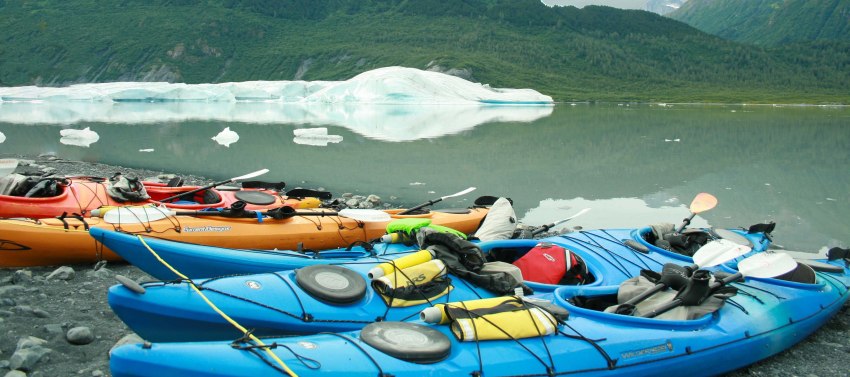
Your gear can easily add 25 lbs. of weight to your kayak. This doesn’t just make it harder to lift and load; the extra weight can damage your kayak while it’s in transit. But we do recommend a dry run at home, just to make sure everything is going to fit.
Whether you’re packing straight into a kayak, or into barrels or dry duffels , it’s a good idea to compartmentalize your packing using small dry bags.
This has two benefits. First, it makes it easier to find your gear, so when you get to camp you can pull out the right dry bag that has your stove, or tent in.
Secondly, it means that if there’s a little water ingress into your hatches, or you open your barrel in the rain, your gear isn’t going to get instantly soaked.
Try to pack your gear evenly into your boat to avoid offsetting the balance or trim. Overloading on one side of your boat can mean you have to constantly strain to keep your kayak flat. If you put too much weight at the front of your kayak, the bow will dig in and veer wildly around, but too much at the back and you’ll struggle to track into the wind.
Create a Float Plan
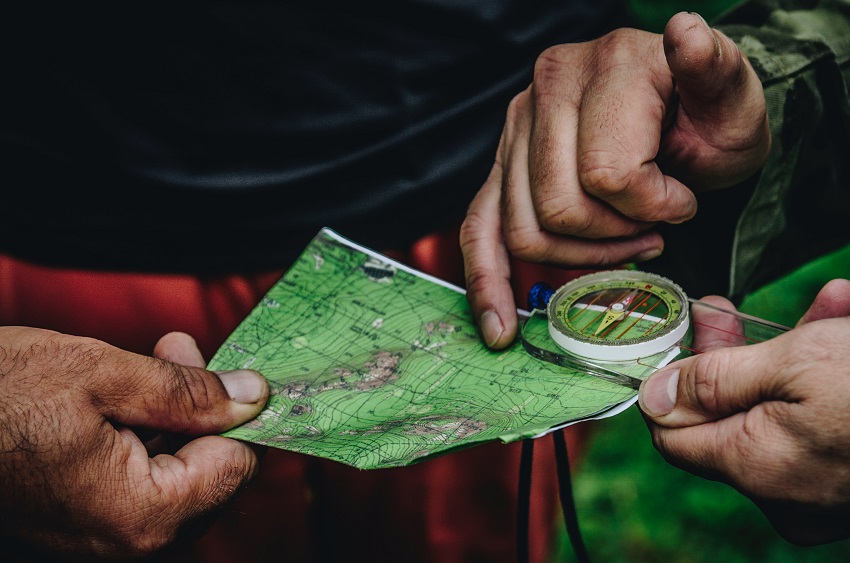
The float plan is your safety link to the outside world. These are important and even in the modern world where we all have phones, these can save your life. You never know, you might not have a cell signal, or your phone might die or take a dunking, so make sure you fill in a float plan.
If you’re not sure what a float plan is, check out our article here . But just briefly, these documents include your rough plan, your team members’ names and vessels, and your vehicle’s location and license plates. These should be left with a trusted friend or family member at home, along with instructions on what to do if you don’t return and how long to leave it before calling the authorities to start a search.
The critical thing here is to remember to get in touch with your home contact when you planned to. Plenty of search and rescue operations have been set into action only to find their believed casualties in a bar celebrating a great trip, having forgotten to phone it in at the end of their day.
Make a Plan B
Your trip shouldn’t be set in stone. When you’re planning your trip, be sure to check out alternative options that you can go for if the conditions change. These could include mid-trip changes and even the potential for hiking out to the truck if you really have to.
You have to be ready to change your plan when you’re going out kayak camping because even the most up-to-date weather forecasts aren’t always accurate. Don’t get too headstrong about your plan and force it when everything is going against you. Some of my best trips – looking back – have been the ones where I’ve been forced to change plans, it’s made me think outside the box and explore new places.
Start Off Gently

So you’re all set and ready to go. The big day is finally here. You’re excited. The crew is excited. But don’t set off at a million miles per hour.
Fully loaded kayaks and canoes are heavy and chances are you have a reasonably long way to go. Start off gently and ease yourself into the paddling until your muscles are warmed up. If you’re setting off straight into a strong headwind, tidal flow, or rapids, it’s never a bad idea to warm up.
You might feel a bit of a fool standing at the side of the river waving your arms around, stretching, and getting that blood pumping, but you’ll feel worse if you pull a muscle within five minutes of hitting the water. Remember to do this each day to avoid a mid-trip strain too.
Related Posts
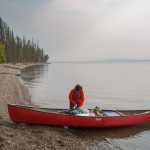
Our guide to canoe accessories covers recreational and tripping gear that you can take with you on your canoe trips.
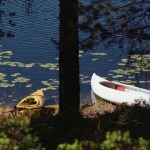
Both kayaks and canoes have been used for thousands of years. But which watercraft is better, and why? Let's find out!
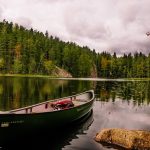
Tandem canoe is a sociable way to hit the water, with enough space and capacity for two adults to get comfortable and load up with all their gear.

In this article, we’ve got all the information you need to decide on the optimal kayak size. Discuss kayak sizes like a pro!
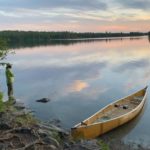
Canoe adventures are popular with many paddlers. This guide is a cumulation of tips, hints, and ideas to help you prepare for your next canoe camping trip.
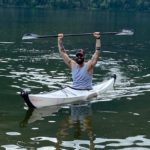
ORU Bay ST is a true masterpiece of design and craftsmanship, a seaworthy, highly versatile kayak that folds down into a box you can carry around.
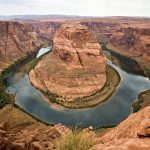
Arizona is the perfect state for year-round kayaking trips! We’ve gathered a list of the best places to go kayaking in the spectacular Grand Canyon State.
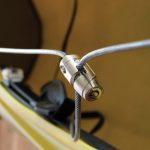
Here, we explain how to lock your kayak securely and then look at some great kayak locks to keep your kayak safe.
Tom "Moose" Kilpatrick
Moose started his paddling life on the ponds and rivers in the South-East of England. He has slowly worked his way north and has spent the last few years paddling in Scotland, both with friends and as a canoe guide. A very experienced and knowledgeable coach and guide across Scotland and the rest of the UK, he spent a summer in Norway and a month in Nepal. He is also a cofounder of PaddleMore.co.uk.
Leave a reply Cancel reply
Save my name, email, and website in this browser for the next time I comment.
This site uses Akismet to reduce spam. Learn how your comment data is processed .
PaddlingSpace.com is a participant in the Amazon Services LLC Associates Program. As an affiliate, we may earn a small commission (at no extra cost to you) when you purchase via our links. Thank you for supporting us!
418 BROADWAY STE Y ALBANY, NY 12207 (518) 533-5454
- Gear Catalog
- Kayak Reviews
- Gear Guides
- Terms and Conditions
- Privacy Policy
We monitor major online stores and alert you about sales, cool deals and price drops. No spam ever, unsubscribe at any time!


- 800-710-6657
- Call Admissions
- Gap Semesters
Sea Kayaking for Beginners with NOLS: Essential Tips and Techniques
Dec 8, 2023
As a beginner to sea kayaking, you might be wondering where to start -- that's where we come in. With years of sea kayaking instruction under our belt, we've got the answers to your burning questions and beginner kayaking tips to set you on course.
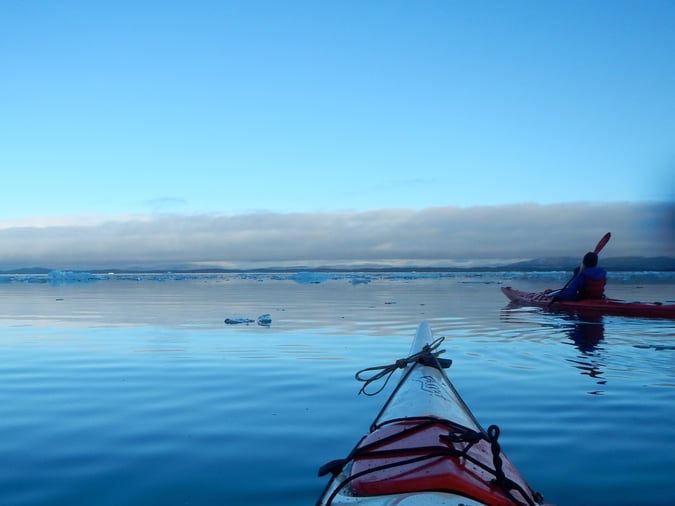
With NOLS, you'll not only develop essential beginner kayaking skills from paddling techniques to navigating the coastline with grace and efficiency, but you'll also have the opportunity to form a profound connection with nature, expand your leadership capabilities, and forge enduring bonds with your "pod" members.
Whether you're a whitewater kayaking adventurer eager to trade in those whitewater rapids for saltwater waves, a sea kayaking hobbyist ready to level up your skills, or completely new to kayaking in all forms, get ready to hone in on the fundamentals with our sea kayaking expeditions.
Is Learning How to Sea Kayak Worth It?
For beginner kayakers, the lists of terms, gear, and skills related just to the fundamentals can seem overwhelming, but rest assured that sea kayaking is not only a fairly accessible skill to learn, it's also a skill that grants you access to the coolest locations and a slew of abilities that can be leveraged in all areas of life.
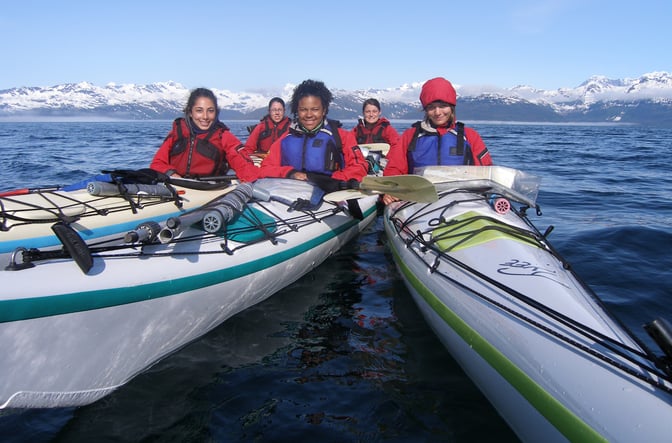
Gain Access to Unique & Adventurous Destinations
At NOLS, the sea kayak serves as a mechanism for wilderness exploration. Our expeditions open doors to extraordinary destinations, providing opportunities to connect intimately with nature and witness vibrant wildlife in new and unique ways.
Each sea kayaking destination promises a thrilling adventure and a unique tapestry of landscapes, wildlife, and conditions that make every stroke an immersion into the wonders of nature.
Sea Kayaking in Patagonia
In the rugged beauty of Patagonia, participants navigate steep-sided fjords that carve through the heart of a pristine wilderness. Gliding through these majestic waterways, you might encounter colonies of penguins, witness sea lion rookeries, or experience the exhilarating sight of sea lions swimming alongside your kayak. The skies are adorned with the majestic presence of albatross, while the ever-changing conditions add an element of unpredictability to the journey.
Sea Kayaking in Baja
Baja, with its enchanting coastlines, offers a kaleidoscope of marine life. As you paddle, be prepared to witness flying fish gracefully soaring above the water, sea turtles gliding beneath the surface, and the majestic presence of whale sharks and manta rays. As the sun sets, the sea comes alive with bioluminescence, transforming the waters into a mesmerizing display of natural light. Amidst this, the surrounding desert landscape adds a stark and stunning contrast to your sea kayaking adventure.
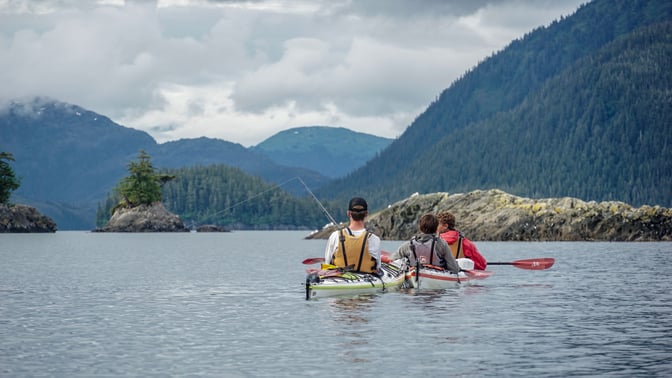
Sea Kayaking in Alaska
In the vast wilderness of Alaska, participants navigate through tide-water glaciers, marveling at their majestic beauty. The waters are teeming with life as humpback whales breach the surface, orcas glide through the depths, and sea lions playfully frolic in the surrounding waves. Sea otters bob in and out of view amongst the waves, adding a charming touch to the rugged Alaskan seascape.
Sea Kayaking in New Zealand
New Zealand, with its diverse ecosystems, provides a canvas for an unforgettable sea kayaking experience. NOLS runs courses in the Marlborough Sounds, renowned for its remarkable wildlife such as penguins, whales, and dolphins. As evening descends, you'll camp on secluded beaches nestled against lush forests, drifting into slumber to the soothing melody of gentle waves caressing the shore.
Whichever destination you choose, a NOLS sea kayak course promises not just a paddling adventure but an exploration of nature's wonders in some of the most secluded corners of the world. It's an opportunity to connect with the environment, witness wildlife in its natural habitat, and forge lasting memories in the midst of these remote and untamed landscapes.
Learn Self-Leadership and Quick Decision Making Skills Through Paddling
Beyond exploring vast oceans and coastlines, NOLS sea kayaking courses foster team-building and self-confidence among beginners and seasoned kayakers alike.
The teamwork required to navigate coastal waters and practice essential rescue techniques with those in your "pod" helps you develop strong communication skills, adaptability, and trust—essential qualities for effective self- and group-leadership.
Our sea kayak courses strike a perfect balance between adventure, personal growth, and enjoyment, providing an opportunity to enhance your skills and broaden your perspectives in some of the world's most remote and stunning locations.
Sea Kayaking Terminology for Beginner Kayakers
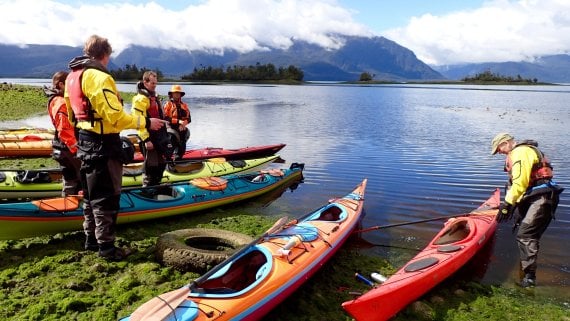
Developing basic knowledge and key terminology will help you communicate effectively with other kayakers when preparing to embark on your first sea kayaking trip. Familiarize yourself with these key sea kayaking terms to get you started:
Kayak Design and Components
- Sea Kayak: Compared to whitewater kayaks, sea kayaks are longer and narrower, designed for open water and coastal environments with features like bulkheads and hatches for extended kayaking trips. Sea kayaks prioritize tracking (maintaining a straight course) and efficiency for covering longer distances. Whitewater kayaks are shorter and more maneuverable, built for navigating fast-flowing rivers.
- Bulkhead: A compartment inside a kayak that creates a sealed compartment, often located near the bow and stern.
- Cockpit: This opening allows kayakers to sit inside kayaks.
- Deck Lines: Rigging on the kayak deck that is used for securing gear, providing handholds, and assisting with rescues.
- Hatch: A watertight compartment on a kayak, sealed with a hatch cover, used for storing gear and providing buoyancy.
- Kayak Paddle: A double-bladed paddle used by kayakers for propelling and steering their kayaks through the water. The kayak paddle comprises a paddle shaft and two paddle blades, one on each end of the shaft.
- Rudder: A movable fin or blade, often controlled by foot pedals, used to aid in steering the kayak.
- Skeg: A retractable fin near the stern of the kayak, used to improve tracking by reducing the impact of wind and current. Most sea kayaks have either a rudder or a skeg.
- Spray Skirt: A waterproof cover worn by the paddler that attaches to the cockpit. The spray skirt prevents water from entering the kayak cockpit while the kayaker paddles.
Paddling Technique Terms
- Forward Stroke: The primary paddling technique for propelling the kayak forward efficiently.
- Reverse Stroke: Paddling in the opposite direction of a forward stroke to slow down, stop, or move backward.
- Sweep Stroke: A wide, sweeping paddle stroke used to turn the kayak.
- Draw Stroke: A stroke used to pull the kayak sideways, useful for tight turns or moving parallel to an object.
- Sculling Stroke: A technique where the paddle blade is moved back and forth in the water to provide support or maintain balance.
- Bracing: A paddling technique used to prevent capsizing by using the paddle for support against the water.
- High Brace: A bracing technique with the paddle held horizontally above the water to prevent a capsize.
- Low Brace: A bracing technique with the paddle blade held horizontally close to the water's surface to maintain stability.
- Edging: The technique of tilting the kayak by shifting one's body weight, influencing the kayak's direction and stability.
Emergency Response and Rescue Terms
These techniques cover a range of emergency response and self-rescue methods, enhancing a kayaker's ability to handle various challenging situations on the water. While self-rescue techniques are essential for all kayakers to be proficient in, we advocate for a proactive approach to avoiding high-risk conditions.
While our courses prioritize the development of essential sea kayak self-rescue techniques, we also note that these skills should not be relied upon or used as an excuse to attempt sea kayaking in high-risk conditions. For a deeper overview of sea kayak self-rescue techniques, join us in one of our sea kayaking expeditions and courses .
- Self-Recovery Techniques: Skills used by kayakers to recover from a capsize and re-enter the kayak without assistance.
- Wet Exit: The process of intentionally exiting the kayak while in the water, typically performed in training for self-recovery scenarios.
- Re-entry: The process of getting back into the kayak from the water, a crucial skill in capsize situations.
- Assisted Rescue: Techniques where kayakers help each other recover from a capsize and re-enter the kayak.
- Towing: The method of using a tow line to assist or be assisted by another kayaker during a rescue situation.
- Scoop Rescue: A rescue method involving the assisting paddler using their kayak like a scoop to help the capsized paddler re-enter.
- X Rescue: A rescue technique involving two kayakers forming an "X" shape to stabilize and assist a capsized paddler.
- Paddle Float Rescue: Using a paddle float to create additional buoyancy for self-rescue or assisting others.
- Stirrup Rescue: A method of assisting a paddler in re-entry by using a stirrup or step to make the process easier.
- Cowboy Rescue: A self-rescue technique where the paddler flips the kayak upright and quickly climbs back in without assistance.
- Bilge Pump Use: Using a handheld bilge pump to remove water from the kayak after a capsize or wet exit.
Essential Kayaking Gear for Beginner Kayakers
In addition to the sea kayak and paddle mentioned above, the following kayaking gear items are must-haves for every beginner kayaker and seasoned paddler alike.
-1.jpg?width=672&height=446&name=Kayaking%20(1)-1.jpg)

Essential Kayak Gear
- PFD (Personal Flotation Device): This indispensable piece of gear serves as a personal buoyancy aid, functioning much like a life jacket. Worn by kayakers, the Personal Flotation Device enhances personal well-being while navigating the water and reduces the risk of drowning in case of capsize.
- Handheld Pump: A pump is a critical tool for efficiently removing water from a kayak after a capsize. Travel with the pump in a place that is secure and easy to access quickly.
- Paddle float: These are used to aid in self-rescue or to help another paddler get back in their boat. Sea kayaking paddle floats usually come in two styles: inflatable or foam. The inflatable floats take up less space. The foam floats can be a bit faster to use for novice paddlers. Travel with the paddle float in a secure and accessible location on your boat.
- Spare paddle: A spare paddle is necessary in the event of a capsize where you lose control of your paddle.
- Light source: Sea kayaks are low-profile vessels making them hard for larger boats to see. It is crucial to have a light source when navigating in conditions of darkness or low light. International COLREGS (Convention on the International Regulations for Preventing Collisions at Sea) asserts that white light is mandatory for nighttime operations, but it doesn't necessarily need to be continuously active—simply accessible when required.
- Marine flares: Marine flares are an efficient way to signal distress at sea. Make sure your flares are stored safely and check the expiration date before each trip.
- Tow rope (if traveling with another boat): Waist belt tow ropes with a quick release make it easy to tow another boat in need. The quick-release feature allows you to disconnect from the other boat in an emergency.
- Sound signaling device: A whistle is helpful for communicating with other paddlers. Coast Guard regulations may require paddlers to carry a sound signaling device that can be heard by other, often larger, boats.
- VHF Radio: A fundamental communication tool, the VHF radio is an essential component of sea kayaking. Used for both routine communication and emergency purposes on the water, it enables kayakers to stay connected with fellow participants and instructors, facilitating the swift initiation of rescue procedures if necessary.
- Wetsuit: Wetsuits are typically crafted from neoprene material for thermal insulation in cold water environments. The wetsuit's innovative design allows a thin layer of water to enter and form a warm buffer against the body, providing comfort and warmth in chilly waters. Note: Wetsuits are optional! They can be expensive and wearing a wetsuit can be avoided if you are deliberate about the kinds of conditions you paddle in (warmer water, mild conditions, with a partner instead of alone).
- Drysuit: Unlike the wetsuit, which provides insulation via a layer of water, drysuits are designed to use air insulation to keep the kayaker warm and dry. The drysuit is a waterproof, full-body garment that kayakers wear to stay dry in cold water conditions. This protective layer is crucial to maintaining body warmth and comfort during extended paddling sessions, particularly in cooler climates. Note: Drysuits are optional! They can be expensive. Purchasing and wearing a drysuit can be avoided if you are deliberate about the kinds of conditions you paddle in (warmer water, mild conditions, with a partner instead of alone).
A Deeper Look at Technical Skill Development With NOLS
Foundational paddling techniques.
Embarking on a sea kayaking adventure is an immersive experience, and at NOLS, we understand that the journey begins with mastering the art of paddling.
Our comprehensive sea kayaking courses place a strong emphasis on developing foundational techniques needed to paddle correctly and form the bedrock of your skills.
1. Forward Stroke Proficiency
The forward stroke is the engine that propels your kayak forward, and at NOLS, you'll practice and become proficient in the basics. Instructors guide you through the nuances of a powerful yet efficient forward stroke, teaching you techniques to help each paddle stroke maximize your speed and minimize energy expenditure. You'll learn the proper torso rotation, paddle placement, and follow-through techniques contributing to a smooth and efficient glide through coastal waters.
2. Corrective Strokes to Regain Control
Navigating through currents, winds, and varying water conditions demands a repertoire of corrective strokes. Our courses focus on developing corrective techniques such as sweep strokes, draw strokes, and rudder strokes. These strokes enable you to maintain control, make precise turns, and navigate through obstacles with finesse.
Understanding the dynamics of each corrective paddle stroke is fundamental to becoming a skilled sea kayaker, and our instructors provide hands-on guidance to help you grasp these techniques effectively.
3. Bracing Techniques for Stability
Maintaining stability on the water is important in preventing capsizing, especially when faced with unexpected challenges. NOLS sea kayaking instructors teach essential bracing techniques that enhance your ability to recover from a potential capsize.
Whether it's a low brace for maintaining balance in choppy waters or a high brace for stability in turbulent conditions, you'll develop the muscle memory and confidence needed to keep your kayak upright.
4. Efficient Maneuvering with Edging
Edging is a nuanced skill that adds a layer of finesse to your paddling. Our instructors guide you through the art of edging your kayak, allowing you to tilt it slightly to one side.
This technique enhances your maneuverability, enabling you to turn more efficiently and navigate through tight spaces with ease.
With practice, you'll gain a deeper understanding of how your kayak interacts with the water in various positions, contributing to a more intuitive and enjoyable paddling experience.
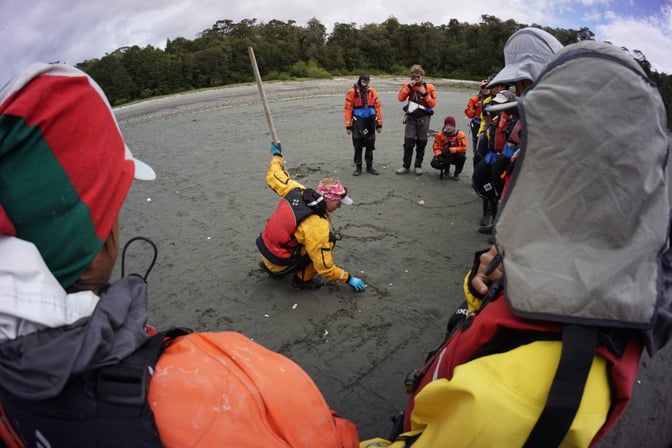
Coastal Navigation Basics
What's awesome about NOLS sea kayaking expeditions, in particular, is that you'll get to use sea kayaking to explore the wildest, most beautiful, and remote coastal locations on our planet.
During a NOLS sea kayaking course, you will learn key coastal navigation skills that help you explore these locations more effectively.
Additionally, navigating in the challenging coastal environment will develop your communication, decision-making, and problem-solving abilities. As you become more proficient in coastal navigation, you'll gain confidence in your ability to help your pod plan routes, estimate travel times, and adapt to changing weather conditions.
Our focus on these essential navigation skills will provide a solid foundation for further sea kayaking adventures and recreational paddling along various coasts.
1. Chart Reading and Interpretation
Navigating coastal waters begins with the ability to read nautical charts accurately. NOLS courses provide a comprehensive understanding of the symbols, contours, and annotations found on these charts.
Instructors guide participants through the intricacies of chart reading, empowering them to interpret information crucial for coastal navigation. From identifying underwater features to understanding depth contours, you'll gain the skills needed to navigate effectively along the coastline.
2. Tidal Dynamics and Planning
Tidal patterns play a significant role in coastal navigation, influencing water depth, current strength, and potential hazards. NOLS courses immerse participants in the study of tidal dynamics, teaching you how to read tide tables and predict tidal movements.
Understanding the ebb and flow of tides becomes essential for planning routes, exploring tidal zones, and effectively navigating through shallow areas. This knowledge is a key component of becoming a confident coastal kayaker.
3. Route Planning for Coastal Exploration
Planning a route along the coastline also involves taking a strategic approach that considers currents, wind patterns, and potential points of interest.
With NOLS, you'll learn key route-planning skills like how to identify suitable landing sites, plan for potential challenges such as headwinds or tidal currents, and create a comprehensive navigation plan that maximizes the enjoyment of your coastal journey.
4. Practical Application through Coastal Expeditions
At NOLS, we believe in learning by doing. Our courses incorporate practical coastal expeditions, allowing participants to apply their navigation skills in real-world scenarios. Whether paddling through rocky coves, exploring hidden inlets, or navigating around coastal features, you'll have the opportunity to put your coastal navigation knowledge into practice, reinforcing the skills acquired in the classroom.
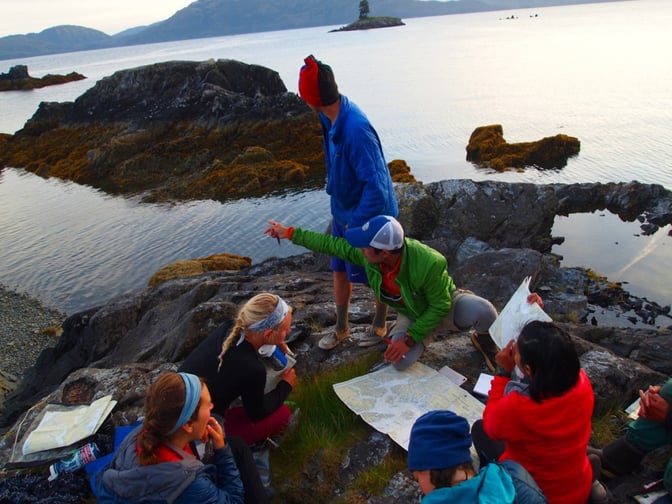
Reading the Elements: Water and Weather Conditions
Embarking on a sea kayaking adventure involves not only navigating through water but also understanding the ever-changing dynamics of weather.
Learning how to interpret water and weather conditions properly is essential when it comes to assessing risk conditions and creating enjoyable experiences on the open sea.
Our courses start with the basics and go beyond, equipping you with the skills needed to read the elements and make informed decisions while paddling.
1. Interpreting Water Conditions
Understanding the language of the water is fundamental for any sea kayaker. Our instructors provide you with insights into interpreting water conditions, whether it's deciphering the movement of currents, recognizing wave patterns, or identifying potential hazards beneath the surface. By developing a keen awareness of water dynamics, you'll be better equipped to navigate with confidence and awareness in various coastal environments.
2. Weather Awareness and Forecasting
Navigating the open sea requires a solid understanding of weather patterns and the ability to anticipate changes. Delve into the principles of weather systems and learn to interpret cloud formations, wind direction, and barometric pressure.
With the hands-on experience of a NOLS course, you'll gain the skills needed to analyze weather forecasts, make real-time assessments, and plan your sea kayaking adventures based on current and forecasted weather conditions.
3. Wind and Its Impact on Paddling
Wind is a significant factor in sea kayaking, influencing both the difficulty of paddling and the risk conditions of your journey. NOLS courses provide insights into the effects of wind on kayaks, teaching techniques to paddle efficiently against headwinds and harnessing the wind for assistance when needed.
Understanding wind patterns and their impact on the water is essential for making strategic decisions during your sea kayaking expeditions.
4. Coastal Microclimates
Coastal environments are renowned for their diverse microclimates, where conditions can vary significantly over short distances. NOLS courses highlight the importance of recognizing and adapting to coastal microclimates.
Whether paddling along cliffs, through sheltered coves, or across open bays, participants learn to navigate these dynamic environments with an understanding of how microclimates can influence wind, temperature, and overall weather conditions.
5. Decision-Making in Changing Conditions
Risk management is paramount in sea kayaking, and at NOLS, we emphasize the importance of making informed decisions based on changing water and weather conditions.
Participants learn to assess risk factors, modify their plans when necessary, and prioritize well-being without compromising the enjoyment of their journey. Our instructors guide you through practical scenarios that simulate changing conditions, allowing you to practice informed decision-making in a controlled environment.
Beginner Kayaking Tips: Getting Ready for Your First Sea Kayaking Trip with NOLS

Mental and Preparation for Beginner Sea Kayakers
Embarking on your first sea kayaking trip is an exciting venture into the realm of adventure and personal growth. To set yourself up for a rewarding experience, consider these beginner kayaking tips to help you prepare. Preparing both physically and mentally will not only enhance your enjoyment but also set the stage for a successful journey into the world of sea kayaking.
Physical Readiness
Preparing for your first sea kayaking expedition with NOLS doesn't demand the same aerobic threshold as backpacking or climbing.
Unlike these activities where speed may be influenced by individual fitness levels, sea kayaking relies more on efficient paddling techniques than sheer strength or typical fitness markers. Fast backpackers often find themselves paddling at a similar pace to everyone else, emphasizing that success on the water is more about mastering the right techniques than pushing physical limits. To prepare yourself physically, engaging in simple movement exercises should be enough.
At NOLS, we start by prioritizing practice sessions in calm, shallow water to help you familiarize yourself with efficient paddling movements, allowing your muscles to adapt and enhance their memory for the journey ahead.
By emphasizing technique over sheer strength, you'll discover that sea kayaking is an accessible and enjoyable adventure for individuals of various fitness levels.
Adopting a Growth Mindset
Approach your first sea kayaking trip with a growth mindset—a willingness to embrace challenges, learn from experiences, and celebrate the process of improvement. Sea kayaking may present moments of uncertainty, especially for beginners, but viewing these challenges as opportunities for learning can turn obstacles into achievements.
Some tips for adopting a learner's mindset include:
- Be open to new experiences and willing to try new techniques.
- Accept feedback from your course leaders and fellow participants.
- Focus on the present moment and soak in the natural beauty of the environments you paddle through, such as hidden coves and star-filled skies.
Embrace the learning curve with enthusiasm. Cultivate patience and resilience, recognizing that growth often occurs outside of your comfort zone. The more open you are to new skills and experiences, the more rewarding and transformative your sea kayaking journey will become.
Start Planning Your First Kayaking Trip in Coastal Waters
Unleash the paddler in you, explore the beauty of coastal waters across the world, and discover the incredible potential that sea kayaking holds for your mind, body, and soul.
Your adventure begins now—explore NOLS sea kayaking expeditions and make waves in the world of sea kayaking!
What essential skills do I need to learn before starting sea kayaking?
As a beginner, you will need to learn basic paddling techniques, understanding of tides and currents, navigation, and self-rescue procedures. Sea kayaking is relatively easy to learn, and with proper instruction, you'll develop confidence quickly. When you join a NOLS course, we'll teach you these essential skills to help you prepare for your sea kayaking adventure.
How does participating in a NOLS course prepare me for sea kayaking?
A NOLS course emphasizes personal growth, leadership development, risk management, and environmental stewardship. Along with teaching technical sea kayaking skills, our instructors focus on developing your leadership abilities. Paddling serves as a mechanism for exploring remote and captivating locations. We tailor our lessons to your skill level, making the courses accessible to total beginners and more experienced students alike.
What are the precautions to consider when attempting sea kayaking as a beginner?
While embarking on a sea kayaking journey, it's essential to consider risk management. As a beginner, you should be accompanied by experienced kayakers or instructors who will guide you in assessing potential risks and applying proper risk mitigation strategies. NOLS strongly emphasizes risk management and awareness in our courses, giving you confidence in making informed decisions while out on the water.
What are the physical requirements for new kayakers embarking on ocean kayaking?
Sea kayaking requires a moderate level of physical fitness, as you'll be paddling for extended periods and potentially encountering changing weather conditions. You'll also need strength and flexibility to execute various paddling techniques. As you embark on a NOLS course, we'll guide you through proper technique and help you develop the necessary physical abilities for a successful sea kayaking experience.
How long does it typically take for a novice to comfortably handle a kayak in the sea?
The time it takes for a novice to feel comfortable handling a sea kayak depends on the individual's learning pace and prior experience. However, with proper instruction and practice, many beginners can become confident in handling a kayak within a few days. By participating in a NOLS course, you'll receive comprehensive instruction, practice in real-life conditions, and ongoing support to help you build confidence and proficiency in sea kayaking.
- Sea Kayaking

NOLS is a nonprofit global wilderness school that seeks to help you step forward boldly as a leader.
Recommended
Capturing alaska, one photo at a time.
- Andrew Bobilya: Taking the Classroom Outdoors
- Educator Expedition: Reading the Rapids on the Colorado River [Video]

I grew up in a small village engulfed by jungle—Oxkutzcab, Yucatan in Mexico. I spent half of my life there. It allowed me to interact and learn alongside turkeys, cats, chickens, piglets and many other animals in the middle of the forest. Ever since, I have kept the outdoors in my life and now with cameras, a couple SD cards, and the support of sponsors, I get to tell the stories of my adventures through still photography and documentary film.

- Conservation
- Club History
- Land Acknowledgement and Reconciliation
- Legal Disclaimer
- About our Trips
Trip Planning and Safety
- About our Courses
- Course Schedule
- Past Courses
- Upcoming Meetings
- Past Meetings
- Howe Sound Stewardship
- Howe Sound Sites Visitor Log Book
- General Discussion
- Buy and Sell
- Manage My Forums
- Understanding Forums
- Family Membership
- Discounts for Members
- SKABC COVID-19 Requirements and Recommendations
- COVID 19 Guidelines for Leaders and Instructors
- Roles of Members of the Executive (under review)
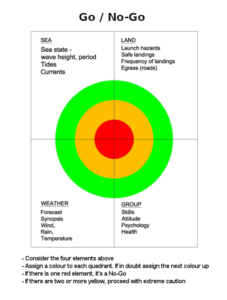
Preparing for your trip
What to bring:
- Gear Checklist — make sure you bring everything you need, including emergency equipment.
- First Aid Kit checklist — recommended list of first aid materials.
Planning and information gathering:
- Medical Information form — when going out on a trip, especially a multi-day trip, use this form to capture everyone's medical information.
- Float Plan — capture important trip and contact information; leave one or more copies with friends or family in case of emergency.
- Launch Site Checklist — points to check before putting the boats in the water. (Recommend creating a laminate with the Go/No-Go graphic on the back.)
- Whistle & Paddle Signals — reminder of whistle and paddle signals to use on the water when verbal communication is difficult.
- First Aid Report form — keep copies of this document in your first aid kit to capture important information in case of an incident or illness.
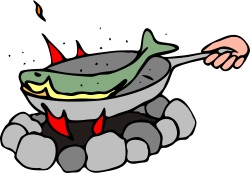
- Meal Planning form or Meal Planning Spreadsheet to ensure you have all meals covered and distribute cooking duties as needed
- Need meal ideas? Check out these recipes , or specifically look for vegetarian recipes.
Destinations and Route Planning Websites
- BC Marine Trail Network Association
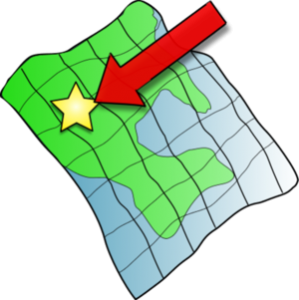
- Gulf Islands National Park Reserve
- NOAA Coast Survey Chart Locator

- Tides and Currents
- Secondary Current Stations Reference Page
- Environment Canada Marine Forecasts
- Marine Forecast Areas, Observation Site and Radio Network
- Oceanography of the British Columbia Coast
General safety and equipment information
- PFDs vs Life Jackets -- understanding the difference
- Cold Water Immersion -- what it is and what you need know
- Sea Kayaking Safety Guide by Transport Canada as referenced in the SKABC Beginners Course
- Digital Tools for Sea Kayaking (2019)
Conservation Best Practices at Camp and While Touring Low Impact Camping
- Plan ahead and prepare.
- Camp and travel on durable surfaces.
- Dispose of waste properly.
- Leave what you find.
- Minimize campfire impacts.
- Respect wildlife.
- Be considerate of other visitors.
The following books can be borrowed from SKABC's library or purchased at MEC:
- "Leave No Trace - A Guide to the New Wilderness Etiquette" (2nd Edition) by Annette McGivney
- "Soft Paths - National Outdoor Leadership School" by Bruce Hampton and David Cole
- "How to Shit in the Woods" by Kathleen Meyers.
Wildlife Viewing Guidelines

There are a number of characteristics unique to sea kayaking that increase the potential for harassment of marine mammals and seabirds. We are low lying, slow moving objects that travel in areas power boats and sail boats rarely enter. From the perspective of the animal, our approach is silent and without warning. Kayakers gravitate towards the shore-line, staying close to the inter-tidal zone where many species feed and find protection.
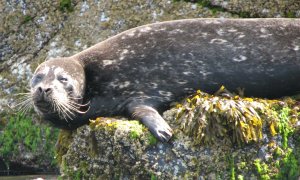
- Minimum viewing distance of 100 metres (approximately the distance of a football field). If your kayaking party finds itself unexpectedly within 100 metres of a whale(s), stop immediately and allow the whale(s) to pass.
- Avoid approaching whales from the front or from behind.
- Always approach and depart whales from the side, moving in a direction parallel to the direction of the whales. Seal and sea lion haul-outs and rookeries should not be approached. Use binoculars to observe animals from a distance and back off at any sign of agitation.
- If you find an abandoned seal pup, leave it alone. Note where it is and when you saw it, and contact the appropriate officials when you are near a phone.
- Sometimes marine mammals appear inquisitive and follow or watch a kayak from the water. In these situations, it is appropriate to observe the animal from whatever distance it chooses however, you should not approach it.
- Do not swim with marine mammals.
- Stay off nesting sites. If a seabird is vocalizing at you, take the hint and move away from what the bird is trying to protect. If you are disturbing seabirds, its predators (for example crows) may use that opportunity to seize eggs or young birds.
- Various birds, sea otters and other species often rest afloat in large groups. It is not acceptable to disturb such groups - you are there for your recreation only, so you can certainly divert around them. How would you like being woken and harassed by fun seekers?
Reporting Cetacean Sightings
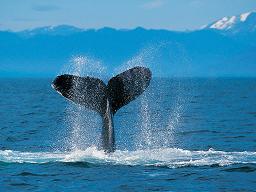
The information is valuable in achieving DFO science objectives and can assist researchers in locating the animals and furthering their investigations.
Running Walking Cycling Mountain biking Swimming Canoeing Horse riding Downhill skiing Cross-country skiing
distance 0.00 km
energy 0 kJ
descent 0 m
What is Mapometer.com?
Mapometer.com is an online map-basedroute planner for sports people. It enables you to map your Canoeing and calculate the distances and elevation profiles of your routes. It also provides training logs so you can track your progress and monitor the calories you burn.
What can Mapometer.com do for you?
- Can I map my paddles to see how far I went? YES
- Can I plan my routes before I paddle them? YES
- Can I view the elevation profile of my canoeing / kayaking routes? YES
- Can I see much energy am I burning on my paddles? YES
- Can I record and track my training over time? YES
- Can I search for new routes or places to go caneoing / kayaking? YES
Advertisements
Please wait...
Support Mapometer from £8 (€9, $10 USD) per year we’ll activate adding markers to your routes (and you’ll get to use the site Ad free).
If you're already a supporter please login to enable markers.
Support Mapometer.com Login
If you’re promoting an event, mapometer.net gives a wider set of markers suited to event organisers.
Try Mapometer.net
Support Mapometer from £8 (€9, $10 USD) per year we’ll activate additional base maps (and you’ll get to use the site Ad free).
Supporters can choose from road map, terrain, cycle map & satellite imagery.
If you're already a supporter please login to enable the layer control.

April 2, 2024
Planning a kayaking trip this summer? You’re in the right place! This is the only kayaking packing list you’ll need!
Why this blog? Hi there! My name is Maddy and I’ve been working as a sea kayaking guide and writer since 2018! I am committed to providing you good and accurate information to help you plan a successful wilderness trip!
Note: this blog uses affiliate links. That means if you choose to make a purchase, I make a small kickback at no additional cost to you.

What to Pack for Kayaking Trips:
Here are the basics of what to pack for a sea kayaking trip, from day trips, to full blown overnight kayaking trips!
What to Pack for Kayaking: Casual Day Trip
Here is everything you will need for a casual kayaking day trip:
- A kayak ! If you’re looking to kayak on protected lakes and rivers for mostly day trips, but want the option to overnight, the best kayak for you is a Wilderness Systems Pungo
- A PFD (lifejacket). If you’re going kayaking, wearing a PFD is a must. I love my Astral PFD , but NRS makes a good budget option .
- A paddle ! For casual kayaking, the paddle you have with you is the best option. For the best kayak paddle for beginners, check out the Werner Skagit or Aquabound StingRay
- Quickdry clothing and sun protection: For a good budget option for kayaking clothes, check out the REI Trailmade collection.
- Map and compass to navigate
- Three ways to call for help in an emergency (a whistle, a signaling mirror, a device to communicate with no cell service)
- A kayaking Safety kit
- A wetsuit . Is the water and air temperature combined less than 120 degrees F? You absolutely need to wear a wetsuit or drysuit . Hypothermia can happen year round and is one of the primary killers of casual paddlers.
- A first aid kit (more notes on first aid kits below!)
Note!! Every now and then you’ll see someone on the internet suggesting that wearing a winter coat and boots kayaking is a good idea. It is not. They will fill with water, become cold, and make self rescue nearly impossible. For a guide to winter kayaking, click here.

What to pack for a sea kayaking day trip:
For a sea kayaking day trip, you’ll need everything listed above and a little bit more. You’ll definitely want a spare paddle, wetsuit, a sea kayak , a spray skirt, and a marine radio. For sea kayaking, you’re also much more likely to need that wetsuit or drysuit.
Kayaking VS. Sea Kayaking: What’s the difference?
Planning on sea kayaking instead of casual kayaking? Sea kayaking, or coastal kayaking, refers both to a type of vessel and a different sport than recreational kayaking (often referred to just as kayaking).
A sea kayak is a kayak greater than 15ft in length with sealed bulkheads, or pockets of air, on either end. In general, in a sea kayak a spray skirt is used to keep waves out of the cockpit. This way, the paddler can kayak in large waves without swamping the kayak. If the boat capsizes, it will not fill with water and sink, unlike a recreational kayak.
A sea kayak and sea kayaking skills and experience are recommended on all exposed coast kayaking trips, anywhere with tidal currents, or anywhere with open water in excess of a few miles. It’s important to remember that sea kayaking is a different sport than kayaking, despite similar roots. Having kayaking experience does not mean you are ready to tackle a sea kayaking route.
Personally, I like to explain it as kayaking is to sea kayaking is what day hiking is to mountaineering— this sounds like an exaggeration, but it’s really not. Sea kayaking (especially on exposed coasts!) requires knowledge of complex weather patterns and tides, deep water rescues in big waves, navigating between islands and complex coast, gathering weather and sea state information and making informed choices about risk, tidal rapids, long term planning, and more.

What to Pack for an Overnight Kayaking Trip:
Wondering what to pack for an overnight sea kayaking trip? This is everything you need to pack for your overnight kayaking trip. You’ll need your camping gear + all the day trip kayaking gear listed above!
Sleep System for Sea Kayaking Trips:
Keep in mind that the key to a happy sea kayak camping trip is gear that will dry quickly. Despite your best efforts, things will be wet. This means choose synthetic over down!
- Nemo Temp Synthetic Sleeping Bag (budget friendly) OR Nemo Forte Endless Promise (higher end)
- Nemo Tensor Sleeping Pad (changed over from Big Agnes bc this one is equally comfortable comparably priced and packs down much smaller
- Waterproof Sea to Summit Compression sack for Sleeping Bag
- A freestanding lightweight tent. Read about the best tent options here!

Where can I get accurate weather for Sea Kayaking?
When sea kayaking, having accurate weather is extremely important. I recommend using at the barest minimum a VHF marine radio to get the Marine Zone forecast every morning before paddling. In addition, a Garmin InReach can also provide you with up to date weather.
When paddling, it’s really important to note that local weather patterns have far more influence on what you will experience on the water than the generalized forecast. Most especially in remote regions, the generalized forecast will not account for these local weather patterns. This is one of the reasons that hiring a local guide with extensive sea kayaking experience is a good idea, especially if you’re dealing with water temperatures below 70 degrees F.
In general, you can find a good weather forecast for your region at weather.gov in the US.
For example, if you’re paddling in a region with fjords you may be subject to katabatibc winds in excess of 45 knots— extremely dangerous to paddle in. Katabatibc winds are not likely to appear in a marine zone forecast, but a paddler with experience will know what conditions lead to these winds, and where they are likely to crop up.

Kitchen Gear 1-2 People, Sea Kayaking Trip:
- MSR camp stove
- Sea to Summit Collapsable Dish-wear
- 1-2 water bottles, Nalgene recommended. Metal water bottles will sink if dropped, even if you leave a pocket of air
- Sawyer Squeeze water filter (alt: iodine tablets)
- Spork (long enough to reach bottom of dehydrated meals while keeping your hand clean ideally)
- Tin mug if coffee drinker
- If with a group and making meals from scratch, Nalgene bowl to eat from. If not, straight from the bag
- Urssack for critter proofing. At the Havasupai campground I did hear reports of folks getting food stolen by raccoons in the night.
- Depending on where you’re paddling (freshwater or not) a water dromedary . If it’s hot out, I budget 5L per person, per day. Usually this is more than plenty.
What if I have a bigger group?
Going with a guided tour for your sea kayak camping trip? Odds are, unless otherwise stated, that your guide will be doing the cooking and kitchen tasks! (Camp cooking is one of my favorite parts of working as a kayak guide!)
If you are planning on doing all the cooking for your group, look into a weatherproof stove like the MSR whisperlite, industry standard for a lot of expedition style trips. You’ll also want to adjust your pot size to a larger pot, and depending on group size and meal needs, perhaps bring more than one pot or stove. I’ll assume that if you’re cooking for a large group, you already have experience meal planning and camp cooking for a group.
If not, I recommend starting with a guided tour, or having your party be responsible for their own meals in groups of 1-2. In my experience, otherwise things get messy when it comes to portion size, timing of meals, and camp tasks. Unless you have guide experience or sea kayak experience specifically with meal planning for groups, put the onus of meal planning on individual members of your part to plan for themselves.
(And like, not to be that person but review each others meal plans!! If the 20 year old who is an awesome paddler but doesn’t have expedition experience plans on bringing just ramen and m&ms for five days, make him repack and replan!!)

Packing Food for Overnight Sea Kayaking Trips:
Getting enough food as you’re paddling is really important. DO NOT just pack ramen and oatmeal to eat for days straight. You will be uncomfortable, and it can even be dangerous.
In general, budget one breakfast, one lunch, one snack, one dinner, and one dessert for a day. Personally, depending on the trip, I will either purchase pe-packed meals in advance, or dehydrate my own meals in advance.
If you will be kayaking longer than a few days or long distances (greater than 15 miles a day), I recommend coming up with a nutrition plan. I am not a nutritionist, but here are a few resources that are a good place to start:
- Ultralight Backpacking Meal Plan
- Backpacker’s Nutrition Guide
The excellent thing about kayaking is that you can fit more food than backpacking, and you can store food at the waterline of your kayak to “refrigerate” it while paddling. On shorter trips, I’ll eat better paddling than I do at home!
Pack more food than you think, and pick meals you know you will like . Those dehydrated meals at REI are not a fun thing to mess around with on a wilderness trip. Anything you don’t like and can’t finish you’ll have to pack out, and it will be much heavier now that it’s rehydrated. If you like pasta, just get pasta.

Electronics to pack for an overnight Sea Kayaking Trip :
- One external battery pack for phone (I usually bring a pretty beefy battery like this one!)
- Garmin InReach
- Canon Rebel SL3 (the most accident-proof budget-friendly camera out there; I have licensed photos to big magazines and tourism boards from this camera) + SD card + spare battery
- A good dry bag (see below!!)
What dry bags are the best for kayaking trips?
The best dry bags for kayaking are small, 10-20L thick and tough dry bags. You want a smaller bag to make packing your boat easier, and you want a tougher dry bag to prevent it from tearing.
After six years working as a sea kayak guide and expedition paddlers I have a lot of advice on what dry bags work for kayaking, and which do not. STAY FAR AWAY FROM LIGHTWEIGHT DRYBAGS. They will rip. You’re going to be jamming them into kayak hatches, and they will rip, they just will.
In addition, stay away from dry bags larger than 20L. While those bags are super great for canoeing or rafting, packing a sea kayak requires all your gear fit inside hatches; a large dry bag will make your life much more difficult and may even be impossible to pack.
For packing your clothes and sleeping bag for kayak camping, Sea to Summits dry bag compression sacks are the best you can invest in. These have lasted me almost four years now, and will keep your stuff both dry and compact. I wouldn’t submerge them, per se, but they are perfectly fine to keep water out for kayaking purposes.
Check out the tough Sea to Summit Big River dry bag in 13L , or the Sealine discover dry bags .
Looking for more on sea kayaking and overnight paddling? Check out this detailed guide to kayak camping for beginners !

Clothes to pack for a kayaking trip:
- Synthetic Puffy Jacket : highly packable, you want something that will pack down to nothing but add a lot of warmth at night.
- 3 pairs of Darn Tough Socks (1 pair worn, one for sleeping, one spare.)
- 4 pairs of underwear
- 1 pair of quick dry shorts
- One pair of long underwear (or just leggings that already have holes in them)
- Hiking pants Good for sun protection and keeping legs safe from rocks while hiking or paddling.
- 1 long sleeve wool baselayers top to wear, one to pack. I like Smartwool , it’s consistently had the most longevity of any baselayer I own. I recommend one baselayer to paddle in and one to sleep in minimum.
- One fleece pullover, thin weight
- Camp Sandals for camp (alt: crocs). I recommend a good pair of hiking sandals; if you get blisters on the way in you can hike in these instead to give your feet a break.
- Paddling Shoes: Neoprene booties OR an old pair of trail runners. In most seasons, I’m team trail runner in the water. This protects your feet from rocks and is WAY more comfortable to paddle in than sandals, which are likely to fill with rocks when you’re walking in water or on beaches.
- Thin wool gloves . Almost never regret packing these! We hiked in late March and it snowed on the way out.
- Raincoat & Rain pants )
- Compression Sack / Drybag for clothes
MISC things to pack for overnight kayaking:
- First Aid Kit
- Emergency Bivvy (Keep in a pocket accessible without removing your backpack. If you fall and break something and cannot easily move, this will make it easier to last a night. I have only ever used my emergency bivvys when helping strangers, but it has never not been worth bringing on the off chance I can help someone in trouble.
- Maps / Charts
- Signalling Mirror
- UL repair kit (tent split covered in duct tape and noso patch or two)
- Pillow (meh, often I do not bring)
- Hand sani, toothbrush, sunglasses
- Binoculars ( So much fun if on the ocean!)
- Bug shirt (if it’s buggy enough for the spray, it is for the shirt too)

First Aid Kit Notes:
You can purchase a first aid kit from REI prepackaged, but I like to build out my own for my own specific backpacking needs. I blister easily, and for me preventative blister care is super important.
This looks like cutting my toenails before trips, duct taping or KT taping over the parts of my feet that blister before I start hiking, and the second I start to feel a hotspot, I take off my hiking boot and use Glacial Gel patches and KT Tape to cover the spot before it becomes a blister.
It is far better to stop hiking and tend to your blisters early than to try and patch up an open wound. For me, I know that on long downhill sections I blister on my pinky toe and the outer edge of my foot, so I slap some duct tape on the usual spots before hiking so it doesn’t rub. On uphills, I blister at my heels, so I do the same.
The most common backpacking injuries tend to be blisters, dehydration, and burns from camp stoves. I come prepared for this by having a burn kit, rehydration packs, and practicing preventative First Aid by staying hydrated, preventing blisters, and being conscious of boiling water and camp stoves (ie, don’t let someone pour freshly boiled water into your coffee cup while you’re holding it!!)

How to pack a kayak for overnight paddling trips:
Wondering how to pack your sea kayak for an overnight paddling trip? Here are some quick tips:
- keep everything you’re going to need during the day accessible either on your deck, in your cockpit, or in your day hatch (the small hatch behind the cockpit in a solo boat.
- pack smaller drybags rather than larger for easier packing
- do your best to keep the weight on the kayak centered; this matters a lot more in solo boats than tandems.
- if you’re paddling into a headwind, load your boat bow heavy. In a tailwind, load your boat stern heavy. This often doesn’t make a huge difference but may be helpful for paddlers in solo boats on longer trips. Tandem boats have so much buoyancy that how you pack them weight wise doesn’t make much of a difference.
- bring some mesh bags or IKEA bags to help carry gear from your kayaks to camp
- ALWAYS ALWAYS ALWAYS carry your kayaks above the high water line and tie them off. Every kayaker will be burned at one point. Learn from my mistakes.
looking to dive into the outdoors this summer? Here’s where to start:
- check out the ultimate guide to planning a solo female road trip!
- learn about backpacking and packing for beginners!
- read about the best kayaking destinations near Seattle!
free resources like this one are made possible by paying subscribers of the Hello Stranger Newsletter . Join the newsletter today to connect with thousands of like-minded adventurers and get gritty and honest adventure stories delivered right to your inbox (aka read my diary).
Love reading about what to pack for a kayak trip share this article on social media:.

- About Us
- Advertising & Affiliates
- Legal Notices
- Printed Maps
- Books & Gear
- Trip Reports
- Recent Activity

- Use the link on Facebook, Twitter, other social media, emails, your blog, website, or any other place you can post a link
- DO NOT use any links with your affiliate ID in places that commercial posting is not allowed, such as certain forums and messageboards
- Remember to disclose that you are an affiliate of the company
- Be aware of the commercial posting policies of the places you are putting the link
- If you are looking for banner ads or other visual materials, check out the affiliate materials page
- Trip Planner
- Benefits of Membership
- Code of Conduct
- Documents & Forms
- Previous General Meetings
- BASK 101: A Guide for New and Prospective Members
- Kayak Safely!
- Safety on BASK Trips
- Safety Gear
- Weather and Swell
- Tides & Currents
- Hypothermia
- Boat Traffic
- Pod Dynamics
- Current Thoughts
- About Kayak Surfing
- Surf Kayaks
- Surf Etiquette
- Surfing Right of Way
- Kayak Surfing Instruction
- Kayak Surfing Locations
- Surfing Links
- Bay Area Environment
- Viewing Wildlife
- Environmental Awareness
- Marine Wildlife
- Environmental Links
- Article Categories
- Trip Reports
- Technical & Gear
- Miscellaneous Articles
- Link Categories
- Kayaking Techniques
- Photo Galleries
- Kayak Clubs
- Symposiums & Events
- Kayak Storage
- Manufacturers
- Miscellaneous Resources
- Classifieds
- BASK Member Login

Welcome to BASK
Bay Area Sea Kayakers (BASK) is a non-profit 501(c7) sports club of several hundred sea kayakers who live throughout the San Francisco Bay Area. Our interests include flat-water paddling, kayak-surfing, expeditions, and playing amongst the rocks, in conditions that range from mild to wild. Our club exists to bring paddlers together for companionship, safety, education, exploration, learning, and great food and drink! We're committed to safety both on and off the water, and our club holds insurance through Paddlesports Risk Management. We offer an inexpensive annual Skills Clinic to members, as well as numerous free clinics on skills, rescue, and safety throughout the year. We welcome as members all individuals interested in kayaking. We’re committed to building a diverse and inclusive paddling club and to sharing our enthusiasm, skills, and knowledge to increase equity and access to our sport.
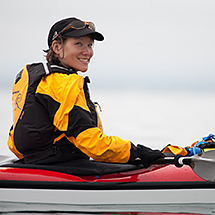
BASK trips range from local to international, and are all member-initiated with shared responsibilities for safety. BASK does not supply boats or equipment, although some members are willing to share their equipment. You have to be a member or a guest of a member to participate in on-the-water BASK events and a signed activity waiver activity waiver --> is required. Follow the links to learn more about the benefits of membership and to join BASK .
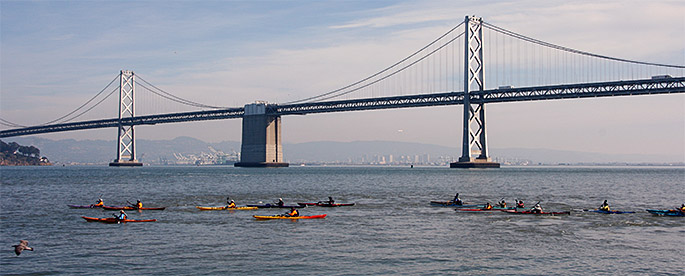
We invite you to attend one of our monthly meetings, either online or in person. They are free and open to the public; in-person meetings include food (suggested donation $8-10). The format of each meeting may vary a bit month to month, but they tend to include members sharing stories, featured speakers, club news, and information about upcoming events. It’s a great way to meet club members and learn about paddling opportunities. For more information see the Events page!
Would you like to speak at a BASK meeting or have an idea for a speaker? Contact the Speaker Seekers . Interested in what type of speakers we’ve had in the past? See a representative list of previous general meeting topics .
BASK Health Guidelines
For the safety of participants at all BASK paddles and other in-person activities, please stay home and join us another time if:
- You're experiencing symptoms of any communicable respiratory illness
- You're testing positive for COVID-19, even if you're feeling well
- In the past week, you've been exposed to someone with COVID-19 via shared air
If you develop COVID-19 symptoms or test positive for COVID-19 within a week of attending an in-person BASK activity, please let the event initiator know. This will allow the initiator to inform other participants, who can then choose to self-test or take other precautions such as obtaining pharmaceutical COVID-19 treatments if they develop symptoms.
Next BASK General Meeting: Wednesday, May 1, (Virtual)
Time : 7-9 pm Location : Zoom Meeting (invitation will be posted on the BASK calendar on the day of the meeting). Note: this meeting will be recorded. About : Join us via Zoom for a virtual meeting to hear the latest club news and enjoy a talk by our featured speakers, Laura Zulliger and Melissa DeMarie. Their topic is "How to 'Freshen Up' Your Kayaking: Cross-Training in Whitewater to Elevate Your Sea Kayaking."
Join Melissa and Laura as we flow together through ways whitewater kayaking can not only enhance your sea kayaking but also deepen your understanding of hydraulics, boat control, complex rescue scenarios and it's also hella fun! We'll guide you through some ideal approaches for folks eager to get started or intermediates looking to build more skills.
Melissa is the Founder and Chief Instigator of California Watersport Collective. She's a dedicated paddlesports coach, fierce competitor, adventurer, mentor, and magnetic community builder both on and off the river.
Laura is California Watersport Collective's Saltwater Program Director but her relationship with the organization began as a student at a whitewater clinic. Having taught sea kayaking since she was 15, Laura began teaching whitewater kayaking (in addition to sea and surf kayaking) in 2018 with Cali Collective and remains a devoted and often-humbled lifelong student of whitewater.
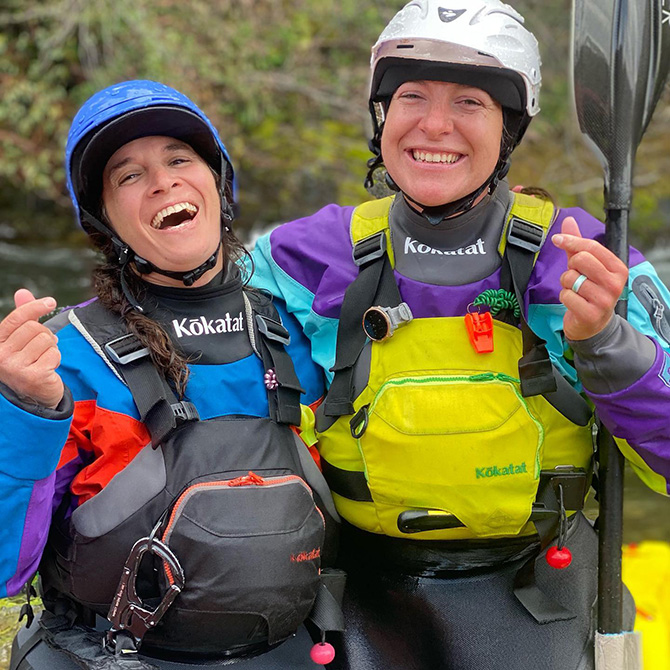
Stay tuned to Currents and the BASK Calendar for more details.
Got ideas for meetings or locations? Contact Brian Alger , BASK President
BASK is proud to be an American Canoe Association Paddle America Club.
Check out BASK's Facebook Group !
Find recorded meetings and other videos on the BASK YouTube channel .
- Fishing Kayaks
- Paddle Boards
- Life Jackets (PFDs)
- Boat Storage
- Paddling Clothing
- Paddling Accessories
- Cool New Gear
- Submit a Review
- Paddling Near Me
- Paddling Locations Map
- Download the Go Paddling app
- Paddling Trips
- Kayaking Trips
- Canoeing Trips
- Share Your Knowledge
- Add a Paddling Location
- Add Your Trip
- All Articles
- Getting Started
- Boats & Gear
- Techniques & Safety
- Camping & Survival
- Join Newsletter
- Create Account
- Message Boards
- Classifieds
- Photo of the Week
- Free Weekly Newsletter
The Float Plan: A Vital Paddling Tool
A sudden sequence of bad weather caused two groups of kayakers to become overdue to the point Search and Rescue units were activated to find them. The first group was recovered within hours; the second group had to survive three days before being found. The difference? The first group had left a float plan behind, the second group had just charged off with out telling anyone where they were going or what their plan was.
Their "plan", that's the key. A float plan is an essential part of any kayak trip that has the potential for developing into a situation where you might not return when you hope to. Weather, injuries, lost gear can all lead to reasons why you can't return at an anticipated time. If you end up being overdue to the point of concern, will anyone know where you were? Would anyone know how to describe your party to aid rescuers into recognizing you in the field? All these questions can be answered by using a Float Plan.
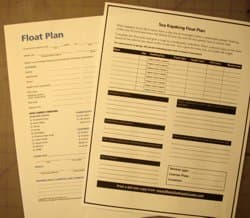
What to include in your float plan
As you can determine, a float plan is exactly what it says: a plan that tells others where you are going to go float (paddle, canoe, kayak, etc.). It provides information on group size, type of gear and color of gear used, special signaling devices to be anticipating and other pertinent information that would aid someone out in the field looking for you.
While float plans vary from organizational boilerplates to a home-made, common-sense listing, the essence of the plan is to adequately describe your group's itinerary (where are you going?, how long will you be there?, when and where will you return?), their description (number in party?, type and color of boats and PFDs?, other telltale visual factors), and what type and color (where critical) of accessories do you have (tents, tarps, other large visual elements? Knowing what means you have for signaling is also very useful (for example: PLBs, signal flares, VFH radio, cell phone)? All these factors will make if easier for rescuers to coordinate a search and save valuable time locating you.
Most float plans begin by including a roster of all members of the party : their names, age, gender and phone number. Part of the search and rescue procedure may be to contact each member's number to learn if that person has made any contact or if any additional information may be helpful.
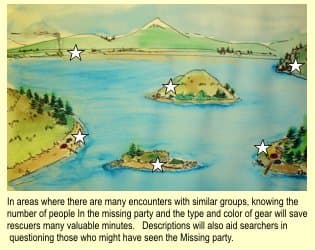
A description of the gear each person has is important, too. It is very helpful to know the type and color of the watercraft (yellow, single sea kayaks, for example) as well as the color of each one's life jacket. This is helpful in direct spotting or through questioning others in the area. Not knowing the color of the boats means extra time checking every craft in the search area.
Each person's skill level should be noted. Presuming prudent paddlers in a group would not jeopardize the safety of lesser-experienced paddlers - or if novices might respond to conditions differently - one can anticipate probable actions a group might have taken.
Back several years ago when Personal Locator Beacons (PLB) finally became legal in the US, a key part of introducing them to the public was the fact that each unit is registered specifically to an individual with all the necessary contact information recorded so the satellite knows exactly who it's "listening" to. Make sure that your information is all updated before you head out with your signaling units. That equipment should be recorded in your Float Plan as well.
Your trip itinerary is a key element in the plan. Where you departed from may be quite obvious, but include it anyway. Also record the anticipated time you will be in route, where you plan to camp. All plans need to be flexible so make sure any possible alternate routes are listed as well. A daily list of potential take-outs would be a big help to SAR units, especially if all the other information has been accurate.
In the case of traveling some distance before putting in, make sure you've described your vehicles including year, make, model, color and license. Placing your float plan document on the dash of your car is a good way to have it available to search and rescuers but also exposes you to those who might like to know how long your car will sit there unattended. Obviously you don't want to leave any valuables in it.
It's apparent that you are providing potential searches with as much information as you can to help them find you should such a situation arise. That's why it's important for you to anticipate any alternatives and include them as well. Obviously we don't always make our intended destination due to human or natural elements. Take the time to choose alternate routes or shorter take-out destinations.
In Alaska, a weeklong kayak trip through Kenai Fjords National Park included a fly-over of the entire route to mark potential emergency take-out beaches all along the course. We eventually had to hold over for three days in one of those spots hoping the pilot would remember that option as well. Anything that will limit the amount of second-guessing on the part of the SAR team will mean a quicker recovery time.
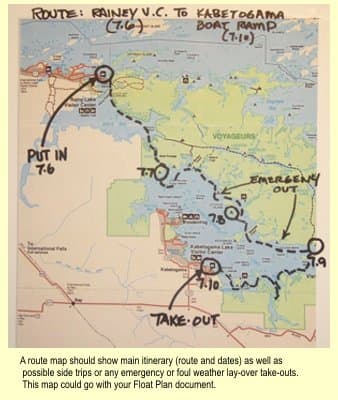
You can create and share a float plan using our Float Plan Tool . In addition, there are several other sites on the Internet that have boilerplate float plans. Just type in "kayak float plan" in the search window.
A key distribution of the plan is the last critical element. Leave one with each member to give to family or friends. It's common to drop one off at the harbormaster's office at the nearby marina. According to website warnings, the US Coast Guard does not accept float plans. I take that to mean they do not accept receipt of them but will obviously respond after the fact to information on them. Lastly, leave one in your vehicle at your launch site.
One often takes extended paddling trips to relax and rid one's self of the labors of life. A float plan may seem like excessive and needless paperwork, but it's far less traumatic than trying to be a survivor when no one knows you're missing or where to even start looking for you when you are overdue.
Float plans make sense. Please use one.
Related Articles
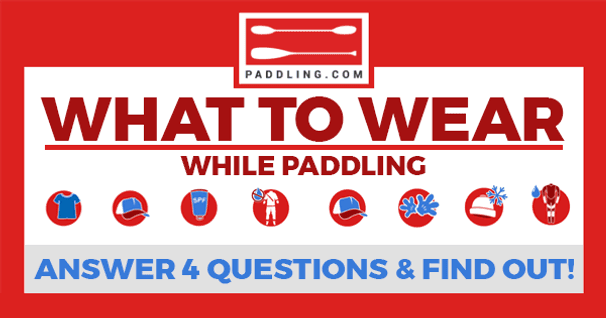
What To Wear Paddling?
Wondering what to wear when going paddling? Answer 4 quick questions and instantly learn what you need…
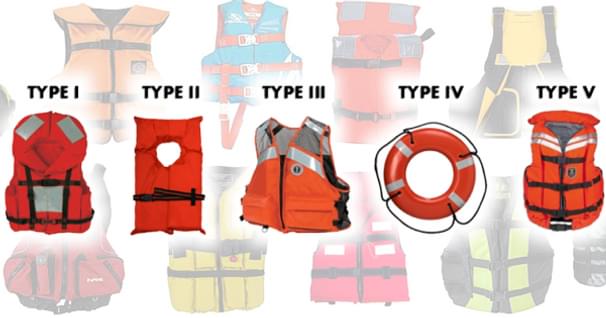
Life Jackets in the New World Order
Tom Watson reviews some of the changes that are in store for defining “Life Jackets” and “PFDs”? It’s…
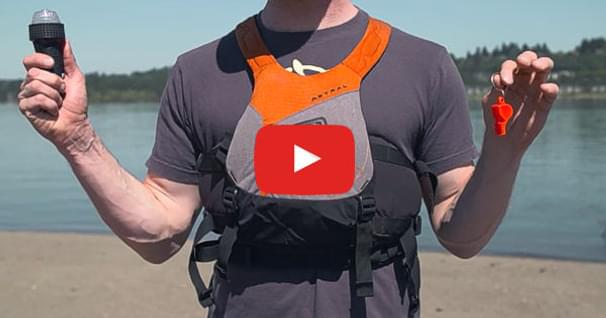
Essential Gear
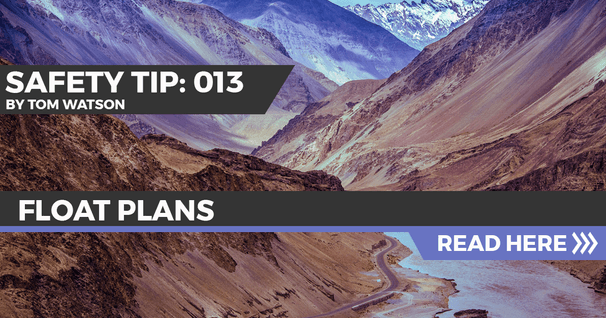
Float Plan Tips
What an itinerary is to a traveler, a “Float Plan” is to a paddler embarking on an extended kayak…
Top International Flight Routes .
Cheap flights, hotels , rental cars and travel deals:
KAYAK searches hundreds of other travel sites at once to find the best deals on airline tickets, cheap hotels, cheap cruises, vacations and rental cars.
Not what you’re looking for? Find thousands of other hotels , flights , car rentals and package deals with KAYAK.
Happy Meals, Happy Paddling: A Guide to Food Planning for Sea Kayaking Trips

My partner Barbara and I were experienced campers and backpackers when we moved to Seattle in 2000, but we didn’t have much experience kayaking. We owned sea kayaks, had taken classes in San Francisco Bay, and we’d even done a kayak camping trip for a week in Prince William Sound, Alaska in the 80s. But we knew that Puget Sound was both fabulous and challenging for sea kayaking, and we’d better have more training before heading out there. As soon as we joined The Mountaineers, we signed up for the Basic Sea Kayaking course.
In our first class, two students were explaining what attracted them to sea kayaking. They were backpackers and had done an arduous hike to a beautiful and remote spot on the West Coast. They had set up camp and were heating water to rehydrate their freeze-dried dinner and make tea. While fixing up this humble dinner, a group of sea kayakers landed on their beach. The kayakers proceeded to pull steaks, a grill, and a Dutch oven to make dessert from their boat hatches. Bottles of wine emerged from the bows. In that moment, the two hikers decided sea kayak trips had some definite advantages over backpacking.
For ten years and more after our first course, Barbara and I volunteered as mentors, lecturers, trainers, and kayak trip leaders for The Mountaineers. We also began touring in our boats. Over the many trips we have done since then, I have planned, tested, and prepared a lot of camping food. Some meals were better than others; some were outstanding. I also developed a method for organizing the food and meal preparation, and I’ve taught seminars both for The Mountaineers and at a kayak symposium on food planning for extended trips.
Enjoying a paddle at Deception Pass.
The importance of meal planning for sea kayaking trips.
There are stories of folks on kayak trips who did not want to be bothered with meal planning, preparation, and clean-up, and who opted to just bring power bars or ramen noodles packages on extended trips. By the third day, they would be trying to trade their food for something, anything else. I confess, for one of the first car camping trips my partner and I did together, I made a similar mistake. I prepared a big pot of cooked brown rice with raisins and tamari-roasted nuts and seeds. Such good nutrition - high quality carbohydrates, protein, and vitamins and minerals. It didn’t go over well. By the third day, I would say the raisins were “plumped up;” Barbara said they were “bloated.” It was not a hit.
Food for kayak camping has to satisfy you but not tax you when you may be cold, wet, and exhausted from a long day of paddling. It’s important, especially on a long trip, to have enough good balance of carbohydrates, proteins, and fats. Sometimes someone would say, well, if there isn’t enough, I could stand to lose a few pounds. Big mistake! For safety and comfort, a paddling trip is not the time to skimp on calories. Paddlers without enough energy may “hit the wall” and not be able to keep up with the group, thereby endangering themselves or stressing out their fellow paddlers when favorable tides and currents are dependent on timing. On top of that, paddlers low on energy may be at risk for hypothermia, and without enough calories, they may be sleeping cold.
Days on the water can also be hot and strenuous. As you lose electrolytes in your sweat there has to be enough salt in the food to avoid feeling weak and faint. Food that doesn’t upset digestion is important, especially if you’ll be paddling through rough water and are prone to motion sickness. Eating the right carbs and enough fat avoids constipation. If you’ll be in bear country, it’s good to avoid cooking something that would smell enticing to a bear. In fact, some kayakers go vegetarian on trips for this reason.
On any group trip, the decision must be made in advance for how meals will be handled: Will each member of the group take turns preparing one or two meals for the whole group, or will each individual or couple cook for themselves? I’ve had the advantage on our trips that I only plan and cook for Barbara and myself, and I know how much we’ll need to eat and the kinds of meals we like. You don’t want to have leftovers, which could be a storage or disposal problem and might attract critters. The folks we do trips with also like to prepare their own meals because each person/couple has strong preferences.
Packing tips
Minimizing packaging is key to reducing time and hassle on the trip. For safety and packing reasons, no cans or glass containers are used. “Leave no trace” means all packaging must be burned or carried home. Burning plastic is not an environmentally sound practice, so the plastic comes home. The amount of paper and cardboard are minimized by pre-measuring into Ziploc bags before leaving home or taking plastic or foil pouches out of their boxes and saving only the descriptions and instructions. We come home with a lot of Ziploc bags that get reused on future trips.
Our cooking kit is compact. Minimizing the cook kit is important for minimizing clean-up and dealing with the limited storage space in a kayak. The stove is a backpacker’s burner that connects to a fuel canister. The stove, lighter, adjustment tools, instructions, and the pot grabber fit into a metal container with a telescoping lid, which serve as a large and a small cooking pot respectively. Then we each have utensils, a small bowl and plate, and a mug with a tight lid. That’s all we need, although we usually add a small plastic cutting board and a cleverly folding, small aluminum stove table.
We typically have two “bear-proof” canisters and one or two duffel bags of food, depending on the duration of the trip. All of the lunch stuff and breakfast stuff is packed together, separated into one-day, per person allotments. The ingredients for each dinner are in a heavy, clear plastic bag, with a note stuck on the inside but readable from outside, detailing the contents. Everything required to prepare that dinner, except the butter or oil, will be in that bag, along with a Ziploc bag of happy hour snacks and a Ziploc bag of dessert treats. Separate Ziploc bags hold the plastic “cream” jars of peanut butter, cream cheese, and butter, while 2-4 oz. Nalgene bottles hold oil and vinaigrette.
Keep breakfast and lunch simple
For us, breakfast is easy. On a short trip, we may have granola with yogurt and boxed orange juice. On a longer trip, Barbara loves a breakfast of Logan bread on which she spreads either peanut butter or cream cheese. Logan bread is dense, rich, and somewhat sweet; it’s more like a bar than bread. It was concocted by climbers who wanted a good, nutritious and easy meal when climbing Mt. Logan in the Yukon. It’s a breakfast that requires no preparation at camp and can be eaten while packing up gear and loading the boats. I need coffee as well, but we use the very best instant to avoid the hassle and mess of grounds.
Lunches are easy too. Sometimes on a day in camp we will have whole wheat flour tortillas, with peanut butter and a handful of trail mix, rolled up like burritos. If we’re out paddling, we will land for a break and lunch will be something ready to eat and easily accessible from the day hatch. Often this will be a power bar, string cheese, and some dried fruit and nuts. We’ll each keep a power bar or a fat Tootsie Roll in a pocket of our PFD (personal flotation device) in case a snack is needed on the water and we can’t land for a break. Tootsie Rolls are good because they’re fairly indestructible, have a long shelf life, and don’t make a mess if they melt. The trick is to remember to take snacks out of any pockets for the night if they aren’t eaten during the day, lest critters chew holes in your expensive and important PFD. Since we store our PFDs in the covered cockpits of our boats overnight, a bear or big raccoon could also damage a boat to get at forgotten snacks there.
What's for dinner?
When we land for the day, the first order of business is to find suitable tent sites. The second is to pull up the boats and begin unloading our gear. Then the tents and tarps are set up and the kitchen area is established. Setting up the kitchen means arranging a shelter with tarps for rain and wind protection, and establishing a sitting area for cooking and eating, away from the tents. It is possible, although it’s never happened to us, that conditions could be so miserable that it’s too difficult to cook. You don’t want to be fussing with food preparation if there’s driving rain with gale force winds. For this reason, most of the meals I prepare could be eaten cold. You wouldn’t want to, but you could. The possibility of really bad weather, bad enough to make it inadvisable to be out on the water for days, means that we always bring several more days of food than we expect to need.
As soon as practicable, we select which dinner we want that night and start eating the happy hour snacks from that bag while setting up our tent. Happy hour snacks are usually salted nuts and seeds or trail mix. On a really hard, cold and wet day, my first task may be to make hot chocolate as well, while Barbara continues to unload gear and set up our site. Dinners are rarely eaten late so dishes can be washed and food hung while it is still light out. All food, drink, dishes, toothpaste, sunscreen, soap, and food preparation items, except the “bear-proof” canisters, are hung from a high tree limb before dark, far away from the tents.
Dinners that I prepare have to meet our criteria and are often tested at home to ensure this. First, the preparation must take no more than ten minutes, and most of our meals take less. This is important not only to save time when you’re tired and hungry, but also to save stove fuel. This requirement rules out most commercial soup mixes, instant rice and most pasta. Many Asian noodles, like ramen, cook in just a few minutes, and there are pre-cooked pouches of rice and vegetables available in supermarkets.
Another consideration is water usage. All of our meals are designed to waste little or no water. On some saltwater trips, fresh water is in short supply. We usually carry large bladders of fresh water (we call them the “seal pups”), clipped into the floors of our cockpits.
As at home, I do the cooking, Barbara does the clean-up. She borrows my rubber boots and wades out from the shore with some biodegradable soap and the dirty dishes. She has found a particular algae that is good for scrubbing the pot. Or sand works too.
Our favorite dinner recipes
Last but not least, we pack food that we will want to eat and enjoy. Barbara has two favorites that she always requests. They both take a little more time and fussing, so I make them on nice days when I’m not too tired and have some extra time.
The first we call the Thanksgiving dinner. In the big cook pot, I rehydrate dried mushrooms and parsley. I then add freeze-dried peas, pre-cooked chicken (from a foil pouch), butter, bouillon, and instant stuffing mix with poultry seasoning to the large pot. When that’s finished cooking, I cover the pot to keep it hot. Then I fix a foil envelope of turkey gravy mix in the small cooking pot, which takes about two minutes. The food in the big pot is divided into bowls, the gravy is poured over, and dried cranberries are added as garnish. This is as complicated and time-consuming as the cooking ever gets.
Barbara’s second favorite is the spaghetti dinner. I cook together two packages of ramen noodles (without the flavor packets), dried mushrooms and parsley, concentrated tomato paste from a tube, sun-dried tomatoes, olive oil, a pre-mixed bag of Italian seasoning, dried onion, garlic, and peppers, and textured soy protein that has the texture and flavor of ground beef. This is served with parmesan and Romano cheese that I freshly grated at home and put in a Ziploc bag.
One of my favorite meals is a hearty split pea soup, made with good dehydrated pea soup flakes purchased in the bulk foods section of our grocery store, freeze-dried corn, pre-cooked real bacon bits, and olive oil. Another is chicken couscous, with pre-cooked chicken from a foil pouch, couscous mix, pine nuts or sliced almonds, shredded unsweetened coconut, curry, butter, and golden raisins. Each of these ingredients is packaged at home in its own Ziploc bag.
What about vegetables?
Obviously, on extended trips we lack a lot of fresh vegetables. Food spoilage is not an issue because sea water is usually 40-50˚F, which ensures that everything stored in the hatches remains cool. However, delicate vegetables won’t survive on a kayak trip given the packing and unpacking of boats as well as how tightly everything is fit into the hatches. It is possible to eat kelp and while very nutritious, it will give you diarrhea if you eat too much. One of our vegetarian friends showed us a better option. She put a wedge of cabbage and a carrot in a Ziploc bag. Separately she carried a small Nalgene bottle of vinaigrette. In camp, the cabbage is sliced thinly, and the carrot is cut into matchsticks. Mixed and served with a drizzle of dressing, the cabbage makes a wonderful salad that can last well into the second week of a trip.
Other options for sneaking more vegetables into your meals are Indian dinners. We’ll purchase two pre-cooked entrees in foil pouches in the grocery store and serve them over instant mashed potatoes or pre-cooked rice. These we test at home first so that we know which ones will complement each other (and not be too spicy for us). In our experience, Jodhpur lentils and Kashmiri spinach, or Madras lentils and Jaipur vegetables, are good combinations. These are compact, quick dinners that add vivid flavors to our meals. The foil food pouches are heated in the water that is then used to rehydrate the mashed potatoes in the bowls. Butter is stirred into the potatoes and the Indian food is poured over the top.
11 th Essentials
What about dessert? Each dinner bag has, in addition to the happy hour snacks and the entrée ingredients, a snack bag with either Dove chocolates or two small candy bars, maybe Snickers or Heath bars.
And what about drinks? Some kayakers claim that the bow of the boat is designed to carry a bottle of wine. That may be true on a short trip, but it won’t be practical on a long expedition. If space allows, we buy a box of wine, take the plastic bladder out of the box, and put it in a ditty bag that we can hang from a tree. The bag will protect the plastic and we have cut a hole in it for the spigot. If it’s a longer trip or we need any spare room for fresh water, we settle for a “fifth” of something like Canadian whisky that comes in a plastic bottle (for example, Black Velvet).
An overcast day on the water.
Be prepared for a “bad day”.
And this brings me to describe my final innovation. Not every trip, but sometimes, there is a “Bad Day.” This may be due to bad weather, sea conditions, health, navigation or equipment problems, friction with others, or all of the above. On days like this, there is no energy or enthusiasm for cooking or clean-up. This is when we have our “Bad Day” dinner — a pouch of pre-cooked rice and vegetables and a pouch of pre-cooked chicken, which are heated in water and emptied directly into the bowls, so the pot doesn’t have to be cleaned. Each dinner includes extra chocolate and two mini bottles (i.e. a “nip” of scotch or bourbon). By the time you have a bad day, you may have run out of all other "adult beverages." It’s satisfying, easy to digest, and quick to fix and clean up.
As one of my friends always said, “If dinner is the best thing that’s going to happen to you all day, it better be good.” Happy meals, happy paddling.
Lead image of Karen's partner Barbara at Ross Lake. All photos courtesy of Karen Borell.
Add a comment.
- Log in to your account
- Create an account or join
HI Ladies. I moved from the SF Bay area where I was in BASK to the Oregon coast. I just found the mountaineers and joined. Do you teach workshops on preparing food for expeditions? I'm tired of just mountain house and need more variety. Have you paddled the Broughtons? Or west coast of Vancouver island?I'm going this June to the Broughtons. THnaks for the article. Make sense. Ken Sund
Thanks for all the useful, kayak-specific information. It wouldn't have occurred to me to take snacks out of my pfd pockets.
"The Mountaineers always have such informative posts! I tried their "Happy Meals for Happy Paddling" recipe during my last kayaking trip, and it was a hit with my paddling buddies. It's amazing how good food can elevate the overall experience. Thanks to the Mountaineers community for always sharing such helpful tips and resources!" For More Info:-https://deepcovekayak.com/
Also In the Blog...
The Mountaineers
Helping people explore, conserve, learn about, and enjoy the lands and waters of the Pacific Northwest and beyond.
- Privacy Policy
- Terms & Conditions
- Mountaineer Magazine
Mountaineers Books
An independent nonprofit publisher
- Bookseller Info
- Press Inquiries
Connect with the Mountaineers Community
Connect with the mountaineers books community.
The Mountaineers®, a 501(c)(3) nonprofit organization. Tax ID: 27-3009280.
Mountaineers Books is a registered trademark of The Mountaineers®, a 501(c)(3) nonprofit organization. Tax ID: 27-3009280.
Click these Menu Headings, or scroll the page.
Ideas, suggestions or broken links? Please email me with details.
For Tidal Predictions from UKHO "Admiralty Easytide" - free 7 day tidal predictions for a variety of UK locations with a "pay" option to get past or future predictions. Nice graphs and you can save your favourite locations.
(The pic shows the data for Loch Melfort in Scotland on 16 September 2004 - heading for neaps)
For FREE Predicitions for the full year, see Tides4fishing.com for a wide range of locations.
The Met Office Inshore Waters Forecast gives the current situation and following 24 hours for all UK Inshore Waters.
The equivalent for Ireland is here .
The Met Office Shipping Forecast gives the current situation and the following 24 hours for Shipping Areas in UK waters. Helpful to gain an overview of what's coming our way.
A summary and explanation of the format and the terms used can be found here - there is also a chart of the Sea Areas mentioned in the forecast.
Click to Listen to the current forecast on BBC Radio 4 - (requires sound and an appropriate player)
The Theyr Forecast gives a useful 3 day overview of temperature, rain, windspeed and cloud cover.
Useful summary graphs indicate this information visually and wind direction is given on a clear map. You can select local forecast data for a range of areas and towns.
(The pic shows the data for Scotland / Oban on 16 September 2004 - very wet and windy! We went home.)
(Note - this site requires subscription - £35 pa - but there is a 14 day "free trial")
The XC Weather site provides useful 3 to 14 day forecast data, including wind speed, direction, pressure etc from a variety of UK locations.
From the Home page, enter the location you want into the postcode or location input box and hit "enter" to be taken to a screen similar to the image on the left.
A1 Surf offers a comprehensive Surf Forecast based on information from Wave Bouys around the British Isles.
Helpful for the surfers clearly, and also for sea kayakers needing to have an idea of likely sea conditions.
( Magicseaweed is another useful resource)
The BBC Weather Section provides a Coast & Sea Summary covering the Shipping and Inshore Waters Forecasts, Tides, Synoptic Charts and Surf Reports.
Weather2 provides a highly detailed service, with a wide range of forecast types including marine / sailing forecasts.
Nice big Synoptic Charts - present, 24 hours , 48 hours , 72 hours
Animated 0 - 132 hour charts
(The pic shows the situation for the UK on 16 September 2004 - and its easy to see just why the weather was so wet and windy with a nasty low out in the Atlantic)
( Wetterzentrale also provide a useful 9 day overview)
Windfinder has lots of weather data, and gives a good 6 day forecast in a easily read visual format.
The link takes you to a UK map - select your location to pull down info like the image on the left.
Easy Reference Sheets - Scotland - Western England & Wales - Eastern England - Summary sheets with paddling speed calculators, wind speed chart, CG contact & MSI Broadcast Times, Marine VHF channels - (.PDF) - intended for printing and laminating so if you would like the Word originals to personalise for yourself, please contact me. Specific MSI and VHF details for Ireland are in this PDF produced by John Rushton - it prints at A4 and then folds up for laminating.
Maps overlaid with tidal data - Ricb250 produced this excellent resource . Click into the relevant area until the tidal stream info appears.
Coastguard Contact details and Operating Areas for Search & Rescue. The UKSKGB "Easy Reference Sheets" also have this information.
Understanding the Shipping & Inshore Waters Forecasts .
Float Plan and Tidal Planning Matrix pro-formas from Cailean MacLeod. (.PDF)
Moon Phases - useful for trip planning.
Sea Temperatures in UK waters.
Marine Safety Information (MSI) broadcast schedules - from the UK Coastguard website - Inshore & Area Forecasts on marine VHF. Similar information for Ireland . See also this draft document (2014) from MCA which includes aerial locations, broadcast times and specific channels for each area.
Marine VHF Channels , including details of Working Channels.
Mayday / Pan pan / phonetic alphabet - summary of protocols and procedures for VHF emergency calls, and the phonetic alphabet.
Handy conversion utility to convert windspeed to and from Beaufort / knots / kmph
XTide - free tides to 2037 for most standard ports.
(Updated 15-Jan-2016 )
UkSeaKayakGuidebook.co.uk
~ The UK Rivers Guidebook and UK Sea Kayak Guidebook Websites, the home of UK paddling on the Net ~
COMMUNITY TRIPS ALMANAC CONTRIBUTE BOOKS RIVERS
South America Sea Kayaking Trips
- Start Date Select Month May 2024 June 2024 July 2024 August 2024 September 2024 October 2024 November 2024 December 2024 January 2025 February 2025 March 2025 April 2025 May 2025 June 2025 July 2025 August 2025 September 2025 October 2025 November 2025 December 2025 January 2026 February 2026 March 2026 April 2026 May 2026 OR, More specific start
- Easy Active
- Challenging
- Food & Wine
- Most Popular
- Private Yacht Charter
- River Cruises
- Scheduled Group Tour
- Solo Travel
- Wildlife & Safari Exploration
- Adventure Options
- Archaeological Site Visits
- Cooking Classes
- Festival Visits
- Fly Cruises
- Hacienda Visits
- Helicopter Tours
- Horseback Riding
- Land & Sea Exploration
- Local Market Visits
- Photography Seminars
- Rainforest Exploration
- Scuba Diving
- Small Ship Cruises
- Small Ship Sailing
- Spa Relaxation
- Stand Up Paddle Boarding
- Urban Exploration
- Village Visits
- Volunteering
- Whale Watching
- Whitewater Rafting
- Wilderness Lodge Exploration
- Wildlife Viewing
- Wine Tasting
- AmaMagdalena
- Aria Amazon
- Cachalote Explorer
- Cormorant II
- Delfin Amazon Cruises
- Douglas Mawson
- Galapagos Angel
- Galapagos Horizon
- Galapagos Legend
- Galapagos Sea Star
- Galapagos Sky
- Galaxy Daily
- Galaxy Diver II
- Galaxy Orion
- Galaxy Sirius
- Grand Majestic
- Greg Mortimer
- Hermes Ultra Luxury Cruise
- La Pinta (UC)
- M/C Endemic
- M/V Anakonda
- M/V Origin, Theory & Evolve
- M/V Santa Cruz
- M/Y Monserrat
- M/Y Passion
- Magellan Explorer
- MS Seaventure
- MV Plancius
- MV Skorpios II
- MV Skorpios III
- MV Stella Australis
- MV Ventus Australis
- National Geographic Endeavour II
- National Geographic Endurance
- National Geographic Explorer
- National Geographic Islander II
- National Geographic Quest
- National Geographic Resolution
- Natural Paradise
- Ocean Albatros
- Ocean Endeavour
- Ocean Explorer
- Ocean Spray
- Ocean Victory
- Royal Clipper
- Santa Cruz II
- Seabourn Venture
- Seaman Journey
- Silver Cloud
- Silver Origin
- Silver Wind
- Star Clipper
- Sylvia Earle
- Treasure of Galapagos
- Ultramarine
- World Navigator
- World Voyager
- South America
Patagonia Camp - Torres del Paine
- Choose from daily excursions
- Hike to the base of the towers
- Kayak or fish Toro Lake
- Search for Condors & other fauna
Authentic Amazon
- Enjoy exploratory canoe trips
- Visit the Parrot Clay Licks
- Kayak though the Indillama River
- Learn from Kichwa women
Galapagos Multisport
- Kayak and snorkel among wildlife
- Learn about Galapagos conservation
- Cycle to Isabela's coastline
- Snorkel in Concha Perla
- Hike the rim of an active caldera
- View giant Galapagos tortoises
Discover Argentina
- Visit Buenos Aires and Tigre Delta
- Enjoy wine tasting in Mendoza
- Explore Bariloche and Patagonia
Torres del Paine Multisport
- Kayak on Lago Grey with icebergs
- Biking with views of the Towers
- Horseback ride with gaucho guides
Awasi Patagonia
- Stay in luxurious Awasi Patagonia
- Join private guided excursions
- Enjoy chef Fredercio Zigler's meals
Eastern Galapagos Catamaran Cruise
- Learn about local conservation
- Mail a letter from Post Office Bay
- Relax on white coral beaches
- Snorkel alongside marinlife
Southeast Islands
- Visit beautiful coral sand beaches
- Snorkel among green sea turtles
- Admire different kinds of birds
Galapagos Southeast Islands
- Visit Cerro Brujo´s lava formations
- Hike across Española Island
- Swim and snorkel at Devil´s Crown
Volcanic Wonders
- Cruise around Kicker Rock
- Hike up Prince Philip's Steps
- Observe Galapagos flora and fauna
- Snorkel or stand up paddle board
Highlights of Southern Argentina
- Visit a penguin rookery
- Wander Tierra del Fuego's trails
- Canoe the Ovando River
- Walk on Perito Moreno Glacier
North & Central Islands
- Observe the Pinnacle Rock
- Snorkel through clear blue waters
- Visit James Bay
Western Islands
- Observe Galapagos giant tortoises
- See the blue-footed boobies dance
- Look for Galapagos penguins
- Cruise along Moreno Point
Northern Islands
- Swim and snorkel at Darwin Bay
- Discover Genovesa Island's birdlife
- Hike to Dragon Hill
Western & Eastern Islands
- Visit the beautiful Junco Lagoon
- Bird watching at North Seymour
- Snorkel & Kayak across Tintoreras
- Discover Sierra Negra volcano
Culinary Adventure in Argentina & Uruguay
- Enjoy culinary classes
- Visit Aconcagua Mountain
- Experience Argentine Tango
- Taste premier wines
Discover Aysen
- Kayak Marble Caves & Cathedrals
- Hike to Exploradores Glacier
- Raft down the Baker River
- Horseback & fly fishing options
Southern Islands
South america travel guide.
- All South America Trips
- All South America Videos
- All South America Travel Stories
- Luxury South America
- South America Cultural Tours
- South America Active Tours
- Torres del Paine
- South America Food & Wine Tours
- Iguazu Falls
- Machu Picchu & Galapagos Tours
- Machu Picchu
- Lake Titicaca
- Salar De Uyuni
- Andes Mountains
Favorite South America All Trips
- Machu Picchu by Train
- End of the World
- Beautiful Buenos Aires & Iguazu Falls
- Chile North to South
- Sacha Lodge
- La Selva Lodge
Top South America Travel Destinations
- Falkland Islands
- Lake District
South America Trips by Departure Date
- 2024 South America trips (829)
- 2025 South America trips (654)
- 2026 South America trips (366)
- May 2024 (638)
- June 2024 (682)
- July 2024 (677)
- August 2024 (678)
- September 2024 (663)
- October 2024 (735)
- November 2024 (735)
- December 2024 (740)
- March 2025 (549)
Top Experiences in South America
- South America Wildlife & Safari Exploration (538)
- South America Cruises (522)
- South America Land Tours (212)
- South America Luxury (144)
- South America Private Yacht Charter (135)
- South America Active (78)
- South America Family (58)
- South America River Cruises (42)
- South America Solo Travel (39)
- South America Trekking (38)
- South America Cultural (37)
- South America Beaches (24)
- South America Most Popular (23)
- South America Honeymoon (16)
- South America Food & Wine (14)
- South America Scheduled Group Tour (3)
South America Trips by Duration
- 5 day trips (147)
- 6 day trips (50)
- 7 day trips (55)
- 8 day trips (180)
- 9 day trips (30)
- 10 day trips (19)
- 11 day trips (10)
- 12 day trips (18)
- 13 day trips (12)
- 14 day trips (5)
- 15 day trips (39)
- 16 day trips (4)
- 17 day trips (7)
- 18 day trips (5)
- 19 day trips (9)
- 20 day trips (11)
- 21 day trips (14)
- 22 day trips (7)
- 23 day trips (8)
South America Trips by Activity
- South America wildlife viewing (616)
- South America kayaking (432)
- South America hiking (412)
- South America snorkeling (407)
- South America small ship cruises (325)
- South America whale watching (107)
- South America stand up paddle boarding (89)
- South America rainforest exploration (83)
- South America village visits (82)
- South America local market visits (66)
- South America archaeological site visits (54)
- South America wilderness lodge exploration (48)
- South America adventure options (48)
- South America camping (47)
- South America fishing (37)
- South America horseback riding (36)
- South America biking (30)
- South America urban exploration (29)
- South America wine tasting (21)
- South America photography seminars (20)
- South America whitewater rafting (19)
- South America hacienda visits (16)
- South America land & sea exploration (16)
- South America homestays (12)
- South America scuba diving (12)
- South America spa relaxation (10)
- South America fly cruises (9)
- South America cooking classes (5)
- South America small ship sailing (5)
- South America skiing (4)
- South America festival visits (4)
Why Travel With Adventure Life
Recognized by.

Hebridean Whale & Dolphin Trust - report any interesting sightings

IMAGES
VIDEO
COMMENTS
The 5 Ps of sea kayaking. #1 Plan (And Then Plan Some More) First of all when planning a kayak trip, get familiar with the area you'll be paddling in - and pick your route, including entry and exit spots and a plan B route, accordingly. Proper planning is half the battle in ocean kayaking, if you ask me. And by "proper planning," I mean:
Safety First: Preparing For Emergencies On A Sea Kayaking Trip. No matter what type of kayaking or other water sports you plan to do, you should always be prepared for an emergency. For starters, life jackets should always be worn. In an emergency, you may not have time to put it on before you need it, as a capsize can happen in a split second. ...
Depending on where you're at and the weather conditions, your emergency kit should include things like a fleece jacket and pants, rain gear, heavy wool socks, a warm hat, a headlamp, energy bars, water matches and a lighter with some fire starter, and even a small tarp and some rope. Of course it's not going to make for the most enjoyable camp ...
Kayaking in Loreto Bay: Six, Seven and eight day tours to the Aquarium of the World, the iconic sea kayaking adventure. Kayaking in God's Pocket: Six days kayaking in one of the most wildlife-filled destination in the world. Kayaking in Johnstone Strait: Six day kayak trips with Orcas in British Columbia. Orca Base Camp Tour: 4 day kayaking ...
Trip Planning: Gear Checklist Sea Kayaking Gear. Download and customize this checklist of sea kayaking and kayak touring gear to make sure you get to the put-in with all the kit you need. Trip Planning: Gear Checklists. A collection of downloadable checklists for camping, rafting, kayaking, and more to help you organize your trip. ...
1. Driftsun Sculpin. The Driftsun Sculpin is a 12-foot sit-inside kayak that will help beginners learn how to handle the sea. This kayak has a foot-operated rudder at the stern that helps you track straighter when battling ocean currents. This kayak is 26 inches wide and it has a maximum weight capacity of 330 pounds.
If you're paddling a sit-on-top kayak or a canoe, you will most likely use a barrel or a large dry bag for the trip, and you can do this at home. However, we recommend packing sit-in kayaks - especially touring kayaks - at the water. Your gear can easily add 25 lbs. of weight to your kayak.
Eklund, 26, says her trip was equally inspired by Natalie Warren and Ann Raiho's 2011 Hudson Bay Bound canoe expedition. Unlike her predecessors, Eklund made the trip in a sea kayak, which made navigating the Hayes River's 45 rapids more challenging. She didn't hesitate to make the 4.5-month expedition solo—the first to do so—though ...
Approach your first sea kayaking trip with a growth mindset—a willingness to embrace challenges, learn from experiences, and celebrate the process of improvement. ... Start Planning Your First Kayaking Trip in Coastal Waters. Unleash the paddler in you, explore the beauty of coastal waters across the world, and discover the incredible ...
Preparing for your trip. What to bring: Gear Checklist — make sure you bring everything you need, including emergency equipment. First Aid Kit checklist — recommended list of first aid materials. Planning and information gathering: Medical Information form — when going out on a trip, especially a multi-day trip, use this form to capture ...
What is Mapometer.com? Mapometer.com is an online map-basedroute planner for sports people. It enables you to map your Canoeing and calculate the distances and elevation profiles of your routes. It also provides training logs so you can track your progress and monitor the calories you burn.
What to pack for a sea kayaking day trip: For a sea kayaking day trip, you'll need everything listed above and a little bit more. You'll definitely want a spare paddle, wetsuit, a sea kayak, a spray skirt, and a marine radio. For sea kayaking, you're also much more likely to need that wetsuit or drysuit. Kayaking VS.
Develop your navigation and planning knowledge. This detailed and comprehensive course goes through everything you need to plan a safe and enjoyable day trip along a coastline. With over 70 lessons the course goes through weather and forecasts, charts and maps, tides and brings all of this together in the planning lessons.
Outside your window, the snow is flying, the wind is blowing, the temperature is thirty below, and the ice is so thick your auger never hits water. No matter - kick up your feet and let your dreams take hold. Explore campsites, waterfalls, portages, and lakes from the warmth of your home. Let Paddle Planner help you discover the wilderness when ...
Prices for a United States sea kayaking trip range from $1,829 to $183,760 for a 5 to 29 days trip in 2024 for a small group kayaking adventure or a private tour with a local English-speaking guide. ... The response from Adventure Life to my first inquiry was prompt and promising. I worked with Jamie Broeckel, Trip Planner, via text, email, and ...
Learn how to plan for a kayaking trip before you head out on the water as explained by World Champion kayaker, Ken Whiting, in this episode of PaddleTV. Unde...
Bay Area Sea Kayakers (BASK) is a non-profit 501 (c7) sports club of several hundred sea kayakers who live throughout the San Francisco Bay Area. Our interests include flat-water paddling, kayak-surfing, expeditions, and playing amongst the rocks, in conditions that range from mild to wild. Our club exists to bring paddlers together for ...
Navigation tools. Distance and route computation. Create a port, anchorage, an area
If you're into kayaking and orcas, this is the kayak camping trip for you. Sea kayaking in the ocean and camping on small islands with otters, seals and bald eagles. Boundary Waters Canoe Area Wilderness, Minnesota. More than 2,400 kilometres of kayak routes, with more than 2,000 camping spots.
Make sure that your information is all updated before you head out with your signaling units. That equipment should be recorded in your Float Plan as well. Your trip itinerary is a key element in the plan. Where you departed from may be quite obvious, but include it anyway. Also record the anticipated time you will be in route, where you plan ...
Pencil is better than pen as even the most experienced tidal planner gets wrong now and again! The times of high and low water do not equal to tidal streams directly. 1. Work out the tides for the 'standard' port. Well a standard port is a 'big' port historically which the tide times and heights have been worked out for.
Get ready for your next adventure. KAYAK Trips. Your free personal travel assistant. Save your favorite results to track prices before you buy. Organize, manage and share your trip itinerary. Receive real-time flight status alerts.
The importance of meal planning for sea kayaking trips . There are stories of folks on kayak trips who did not want to be bothered with meal planning, preparation, and clean-up, and who opted to just bring power bars or ramen noodles packages on extended trips. ... However, delicate vegetables won't survive on a kayak trip given the packing ...
Helpful for the surfers clearly, and also for sea kayakers needing to have an idea of likely sea conditions. The BBC Weather Section provides a Coast & Sea Summary covering the Shipping and Inshore Waters Forecasts, Tides, Synoptic Charts and Surf Reports. Weather2 provides a highly detailed service, with a wide range of forecast types ...
Call 1.406.541.2677. Start Planning My Trip. Paddle South America on one of these 433 extraordinary sea kayaking trips during 2024 or 2025. South America kayaking tours let you explore the shoreline and marine ecosystems and frequently include itineraries with kayaking, wildlife viewing, cruises, wildlife & safari exploration, and snorkeling.
Imray Tidal Planner phone app (£2.99 for 1 year's tides inc. secondary ports) Wind speeds reference chart (see below) Method For Approximately Grading the Sea - MAGS (Gordon Brown) Scottish water levels. UK sea kayak guidebook - trip reports, tons of info. MDCC Trip Organiser Planning sheet and Safety Equipment table.